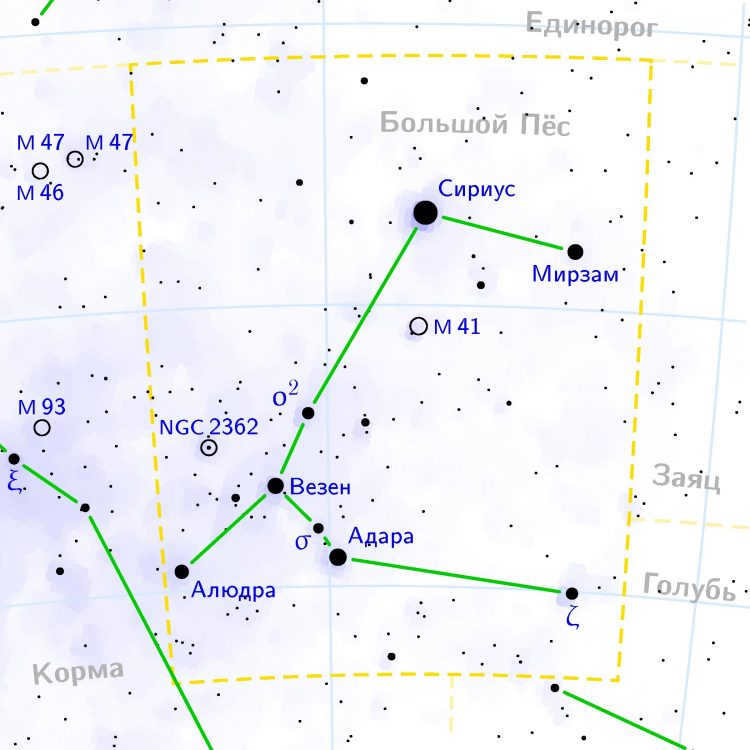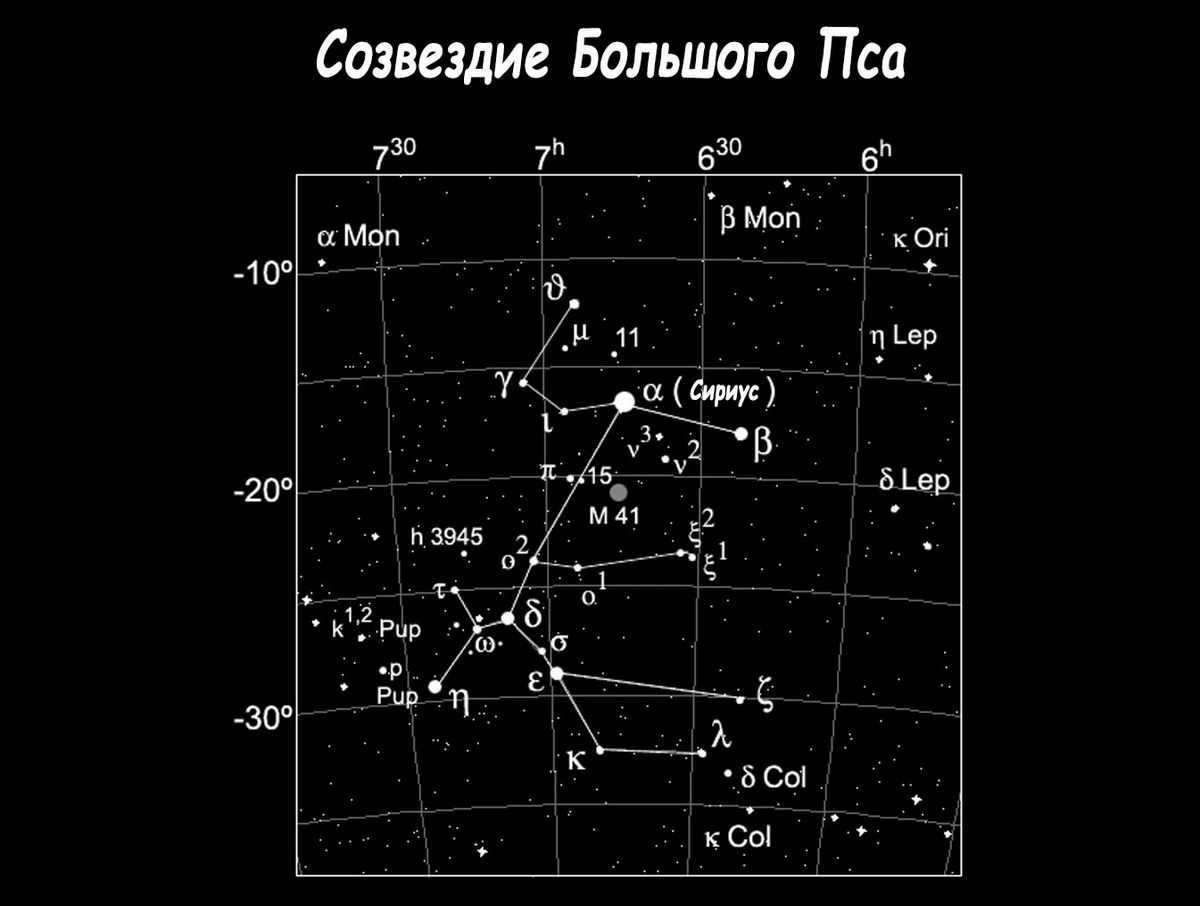
The Big Dog constellation is a small yet highly luminous group of stars situated in the southern region of the night sky and partially intersecting with the Milky Way.
A diminutive “Big Dog” and a diminutive “Puppy”.
One notable characteristic of the Big Dog constellation is that it contains the brightest star, Sirius, which appears as a blue-white celestial body. The name Sirius originates from the Greek word seirios, meaning “brightly burning.” The remarkable luminosity of Sirius (-1.46m) in our sky can be attributed to its luminosity being 23 times that of the Sun, despite its distance of only 8.6 light years.
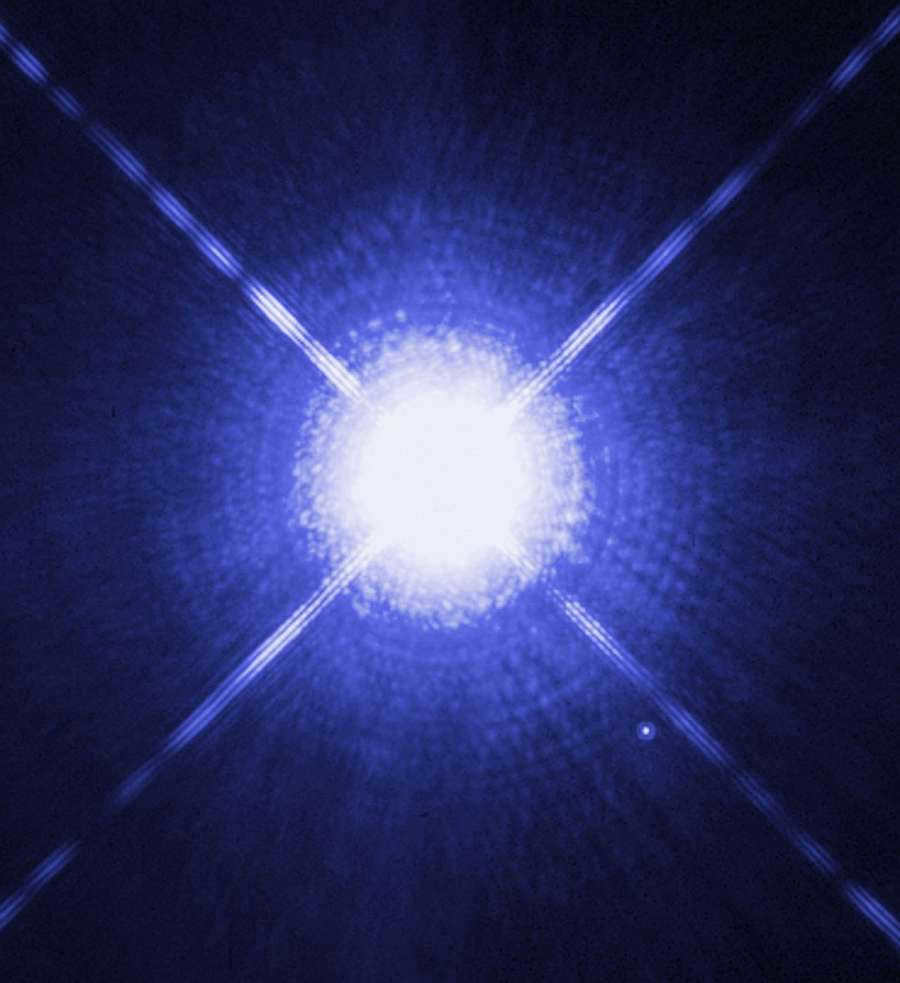
In 1834, Friedrich Wilhelm Bessel, a German astronomer, observed the oscillating motion of Sirius and proposed the existence of another star. This companion star was later discovered by Alvan Clark, an American astronomer, in 1862. The newly found star was given the name “Sirius B” and was affectionately called “Puppy” due to its luminosity being 10,000 times dimmer than “Sirius A”. Despite having a mass similar to that of the Sun, “Puppy” is 100 times smaller in size. This star has a density of 1×10*6 g/cm³, which is typical for white dwarf stars that have collapsed to the size of a small planet and completed their evolutionary process.
Position in the celestial sphere
The constellation Canis Major is particularly prominent in the southern and central regions of Russia. The most favorable time for observing it is during the winter months of December and January. Its visibility is quite limited, as Canis Major does not rise very high above the horizon.
The incredibly luminous Sirius is situated southeast of the Orion constellation, which makes it easy to locate Canis Major. On the northern side of Canis Major, you will find the faint Monoceros, just above which lies the bright star Procyon. To the south, there are the constellations Columba and Puppis, but they lack bright stars in their composition, making it almost impossible to locate Canis Major using them.
Legends and Folklore
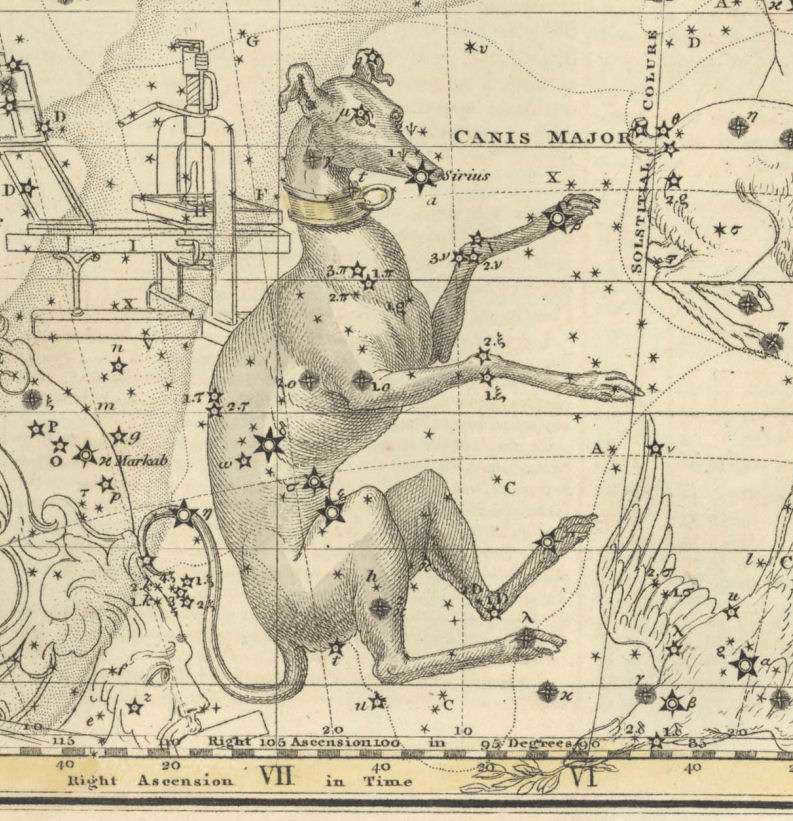
Image taken from a historical atlas published in 1822
According to the ancient mythology of Greece, the original inspiration for the constellation known as the “Big Dog” comes from the loyal dog of Icarius, a shepherd’s daughter. The legend goes that the god Dionysus bestowed upon Icarius the knowledge of cultivating grapes and producing wine as a token of gratitude for her hospitality. During her travels in Greece, Icarius generously shared her wine with local shepherds who were unfamiliar with the effects of intoxication. Not accustomed to the sensations caused by the wine, the shepherds mistakenly believed that Icarius had poisoned them. Fueled by anger and confusion, they tragically killed Icarius and concealed her body in the mountains.
Due to the tragic incidents, Dionysus was filled with anger and decided to inflict a plague upon the shepherds. Additionally, he elevated Icarius, Erigone, and her faithful dog Myra into the heavens. Consequently, the constellations of Volopassus, Virgo, and Big Dog were created, serving as everlasting symbols of these legendary figures.
Hello, everyone who regularly reads our articles and visits our website! We have some exciting news for you today about the Big Dog constellation, which includes the renowned and brilliant star Sirius. Despite its relatively small size, this star cluster boasts the ability to observe over a hundred stars without the need for any technological aids.
Description of the Big Dog constellation
The celestial object known as the Big Dog is part of the group of constellations found in the southern hemisphere. It is notable for not having any meteor streams, but it does contain stars with planets, as well as the Messier object in the form of the star cluster NGC 2287.
Among the list of constellations ranked by size, the Big Dog comes in at number forty-three. It spans an area of approximately 380 square degrees in the night sky.
Key details:
- The Latin name for the object is Canis Major, with the accepted abbreviation CMa.
- There are a total of 148 stars visible to the naked eye within the constellation.
- Among these stars, there are some with a magnitude greater than 6m, with a total of 80 fitting this criteria.
- The Direct Ascension values for the Big Dog range from 6h 07m to 7h 22m.
- The Declination values for the Big Dog range from -33° to -11°.
- The Big Dog is part of the Orion group, along with the Lesser Dog, Unicorn, Orion, and Hare;
- The Big Dog is neighbors with Hare, Corma, Dove, and Unicorn.
Appearance
If you carefully observe the arrangement of the celestial bodies in the star cluster, you can perceive the shape of a dog. It appears as if the dog is standing or sitting on its hind legs, with its snout pointing upwards.
The Canis Major also serves as a symbol for the constellation.
Location of the Canis Major Constellation
The Canis Major constellation can be found in the southern part of the sky. It is situated in the second quadrant, SQ1.
To the southeast of this celestial object lies the Orion constellation. The Canis Major is positioned to the south of Korma and Hare, and its northern boundary is nearly connected to the Unicorn constellation. Additionally, the eastern part of the Canis Major blends with the Milky Way.
This star cluster can be observed in latitudes ranging from +57° to -90°.
The constellation of the Big Dog has been known for centuries, with its observations dating back to ancient Greece, ancient China, and ancient Egypt. As a result, it is difficult to determine precisely when and by whom this cluster of stars was first discovered.
The celestial body is documented in the “Almagest,” the oldest known astronomical catalog compiled by Claudius Ptolemy. In this register, the constellation is recorded as the “Dog.”
Locating the Great Canine Constellation
The star cluster is known for its remarkable brightness when observed in the nocturnal sky, making it relatively easy to locate. The Big Dog constellation does not ascend too high above the horizon, making it most convenient to search for Sirius or Alpha Big Dog.
In order to locate the brilliant Sirius, one must direct their gaze towards the Orion constellation in the celestial sphere. Alpha of the Big Dog can be found nearly in a direct line passing through the three stars comprising Orion’s belt.
Coordinates of the Canis Major constellation
The precise coordinates of the Canis Major constellation, which will aid in your quest: α = 7h, δ = -20°.
Number of stars in the constellation
It is impossible to determine the exact count of celestial objects that the star cluster contains. The quantity is vast and may still include undiscovered and unexplored entities.
Astronomers have identified 154 noteworthy stars. These include luminous celestial bodies, exoplanet-hosting objects, variable stars, supernovae, binary stars, and eclipsing stars.
Information about the number of stars present in a distinct formation within an astronomical object is available. For instance, the Dwarf Galaxy contains over a billion celestial bodies, while the Messier object (M41) consists of only one hundred luminous entities.
The Best Time to Observe the Constellation
The prominent constellation is most easily observed during the winter months. It is particularly visible in mid-December and January. However, the star cluster can only be fully seen in the southern and central regions of Russia. In the northern parts of the country, it is partially obscured by the horizon.
In the autumn, the constellation becomes visible in the early morning sky. By September, it is fully risen by 6 o’clock in the morning.
Notable Stars in the Big Dog Constellation
Scientific experts propose that Sirius, the most luminous star in the night sky, served as the central attraction that gradually attracted other stars to form the Big Dog constellation. Nevertheless, Alpha is not the sole captivating celestial object that comprises this stellar group.
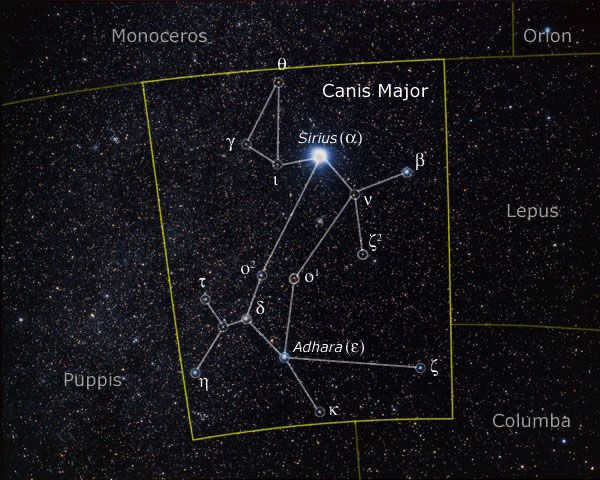
Renowned for harboring VY, one of the largest stars in the night sky, this cosmic entity boasts a modest apparent magnitude of 9.76, rendering it invisible to the naked eye.
VY, a colossal orange-hued luminary, dwarfs the Sun by a factor of 1500 and continues to expand. Its location is a staggering 4,000 light years away from our vantage point.
Amidst the stars that host exoplanets or have a planet in their vicinity, astronomers identify HD 45364, HD 47536, HD 43197, ν² of the Big Dog, and HD 45184.
The primary celestial bodies in the constellation known as Canis Major are.
- Zeta or Furud. Al-furud is the Arabic name for this star, which translates to “singular”. The reason for the plural is that Zeta is actually a binary star system, with a combined visual magnitude of 3.02. It is located approximately 336 light-years away. The main component of this system is a faint blue B-type dwarf star, while the secondary component is an invisible star.
- Delta or Wazen. In Arabic, Al-wazn translates to “heavy” or “heaviness”. Delta, also known as Wazen, is the third brightest star in the Canis Major constellation. It is located around 1,800 light-years away. Delta appears as a light yellow supergiant and belongs to the F-class of stars. Its visual magnitude does not exceed 1.83. Astronomers predict that Delta will eventually evolve into a red supergiant and eventually explode.
- Tau. Situated in the Caldwell 64 cluster (NGC 2362), Tau stands out as the most luminous star within the cluster. This double luminosity star has a visual magnitude that varies from 4.30 to 4.38. It is categorized as a Beta Lyra class variable object due to the presence of a blue-colored supergiant. The distance between Tau and Earth measures 3,200 light years.
- Gamma or Muliphene. With a visual magnitude of 4.11, this celestial object falls under category B. It exhibits the appearance of a giant star with a pale blue hue. The distance between Muliphene and our planet exceeds 400 light years.
- Epsilon or Adara. The Arabic translation of this star’s name is “virgins.” Adara was once considered the brightest star on the celestial chart nearly five million years ago. Currently, it is the second brightest star within the boundaries of the Big Dog constellation. Epsilon consists of a double system, comprising a companion and a B-class luminary. The main body has a magnitude of 1.5. Adara is located at a distance of 430 light years.
- Eta or Aludra. Like Adara, the Arabic translation of Eta’s name is “virgin.” Scientists predict that Eta will undergo a supernova explosion and vanish from the night sky in a few million years. Presently, it appears as a blue supergiant situated 3,000 light-years away from Earth. The visual magnitude of Eta ranges from 2.37 to 2.47.
- Sigma or Urungunite. A supergiant star that is in danger of becoming a supernova in the future. Its brightness is measured at a visual magnitude of 3.47. This celestial object is located 1,120 light-years away from the Sun. Urungunite originated over 17 million years ago as a red hot dwarf.
- P. This is a rapidly moving binary star system. Its rotational speed reaches an impressive 95 kilometers per second. The primary component of this system is a white-yellow dwarf star, while its companion is a luminous star with an apparent magnitude of 9.6. The total visual magnitude of this system is 4.7. It is situated at a distance of 97 light-years.
- R. This star is classified as a double eclipsing star. Its visual brightness has an erratic nature, fluctuating between magnitudes of 5.7 and 6.3. It has a short orbital period, with the time between eclipses being just over a day. The distance to star R is 143 light-years.
The Brightest Star
Sirius or Alpha the Big Dog is one of the closest stars to our solar system, located at a distance of 8.6 light years. Its brilliance is incredibly strong, with a visual magnitude of -1.42, making it easily identifiable on the map of the starry night sky.
The Russian translation of “Sirius” is “Seirios”, “Σείριος” – which means “brightly shining”, “blazing”, “burning”.
Other names for this luminary include:
- Dog Star or Star of the Dog
- Solar Dog (Dog of the Sun)
- Dog
- Lubdhaka
- Aoboshi
- Vacation
- Sotis
- Tonosei
- Ashere
- Cheonlangseond
- Al Shira
- Mugawiyadaha
The cosmic entity is represented by two entities: Sirius A and Sirius B. Friedrich Bessel first proposed in the early 1800s that the brightest entity in the constellation Canis Major is not a solitary entity.
The second entity, unofficially referred to as Puppy, was discovered in 1862 by American astronomer Alvan Clark.
A brief characterization of Sirius A:
- A luminous white-blue main-sequence star;
- Spectral class: A1V;
- Twice the mass of the Sun;
- Magnitude: -1.43;
- Shines 25 times brighter than the Sun.
Brief characterization of Sirius B:
- Presumably appears as a white dwarf;
- Completes a full orbit around the main component in 50 Earth years;
- The satellite is categorized as a member of the DA2 group;
- The puppy’s weight is nearly identical to that of the Sun;
- One hundred times smaller compared to the Sun;
- It has a visual magnitude of 11.20;
- Without the use of professional equipment, it’s not possible to observe the object.
The total age of the Sirius double star system is estimated to be more than 300 million years old.
Alpha of the Big Dog is included in the Winter Circle (Winter Hexagon), and it also complements the Great Southern Triangle (Winter Triangle).
Did you know: The celestial body known as “dog” got its name most likely because in ancient times it appeared in the sky during the period known as the “Dog Days”.
In ancient Greece, this period referred to an especially hot summer season. The Greeks believed that Sirius, the star associated with the dog, possessed magical abilities and caused scorching heat on Earth.
The Tale of the Mighty Canine
Once upon a time, the ancient deity Dionysus roamed the earth and stumbled upon a quaint village. It was there that he encountered a humble shepherd named Icarius and his daughter Erigona. The young girl had a deep affection for a canine companion named Myra.
Icarius graciously invited Dionysus into his humble abode. Moved by the shepherd’s kindness and hospitality, the god decided to show his gratitude in a meaningful way. He imparted his knowledge on cultivating various types of grapes and transforming them into exquisite, aromatic wine.

One day, while conversing with his fellow shepherds, Icarius proposed that they sample the delicious beverage he had prepared. The men found the taste of the wine to be quite pleasing, but unfortunately, they quickly succumbed to its intoxicating effects.
Under the influence of alcohol, the shepherds mistakenly believed that Icarius had maliciously poisoned them. Filled with a desire for vengeance against their supposed “culprit,” they viciously attacked him, resulting in his untimely demise. Once the shepherds regained their sobriety, they were filled with remorse for their actions. In order to conceal their crime, they clandestinely transported Icarius’ lifeless body to a remote location in the mountains, where they buried him without informing Erigone, his beloved daughter.
Erigone anxiously awaited her father’s return, but as the days turned into weeks, Icarius remained absent. Sensing that something was amiss, the young girl embarked on a courageous journey, accompanied by her loyal canine companion, Myra. She hoped that Myra’s keen sense of smell would enable them to track down her father’s whereabouts.
For a considerable amount of time, Erigona and Myra roamed around the village and the mountains. Eventually, the dog stumbled upon the exact location where Icarius was laid to rest.
Overwhelmed by her sorrow, Erigona chose to end her own life by hanging herself from the tree closest to the grave. Shortly after, Myra also passed away due to her intense longing for her masters.
Observing these events from the peak of Olympus, the gods were filled with sadness. Dionysus made the decision to elevate Icarius, his daughter, and their loyal dog to the heavens. As a result, three new constellations appeared in the night sky: the Great Dog, the Maiden, and the Magus.
From a mythological standpoint, the constellation of the Big Dog is associated with two additional myths:
- According to the legend of Orion, a young hunter fell in love with the goddess Artemis, but his feelings were not returned. As a result, Artemis transformed him into a deer. In his new form, the hunter was relentlessly pursued by a pack of dogs. The largest of these dogs, which later became associated with a celestial object, viciously attacked the hunter.
- There is a tale in ancient Greek mythology about a dog and a hare. The dog in this story was known for its incredible speed. One day, it came across a magical hare and the two engaged in a long and exhausting chase. The chase lasted so long that even Zeus grew tired. To commemorate this event, Zeus turned the animals into stone statues, which later became the constellations that we know today.
Fun Facts
- In Latin, the “Dog star” is known as “canis”. This is where the word “vacation” originated from.
- In ancient Egypt, the rising of Sirius signaled the release of the Nile’s waters. It coincided with the summer solstice and was referred to as the “Star of the Nile”.
- The NGC 2362 star cluster is one of the youngest known clusters, estimated to be a million years old.
- The philosopher Seneca described Sirius as a deep red star, a view that was also shared by Ptolemy. However, modern scientists cannot explain why the star is now perceived as pale blue.
- The ancient Chinese referred to the constellation as “Heavenly Jackal” or “Tien-lang”. According to legend, the creature was slain after attacking the Chinese emperor.
- Magicians and psychics believe that the Big Dog constellation possesses mystical abilities. Extended observation of it aids in the development of supernatural powers. It’s as if the starlight unveils hidden potential.
- A dwarf galaxy concealed by the Milky Way was uncovered in the 21st century (in 2003).
- Messier’s object (M41) is sometimes mentioned as the Little Beehive in certain sources.
- In the 18th century, astronomers came across a nebula within the Big Dog constellation that resembled a helmet. It was named Thor’s Helmet. The object is located 15 thousand light years away from the Sun.
- The space object has been listed as Canis Major (CMa) in the catalog of the International Astronomical Union since 1922.
Thank you, dear companions, for staying with us! We trust you had a great time reading the article. Feel free to share your reflections and inquiries in the comments section, and don’t forget to spread the word about this publication on social media. We highly recommend subscribing to our website’s newsletter to stay updated with the latest news. May you continue to marvel at the beauty of the stars. Until we meet again!
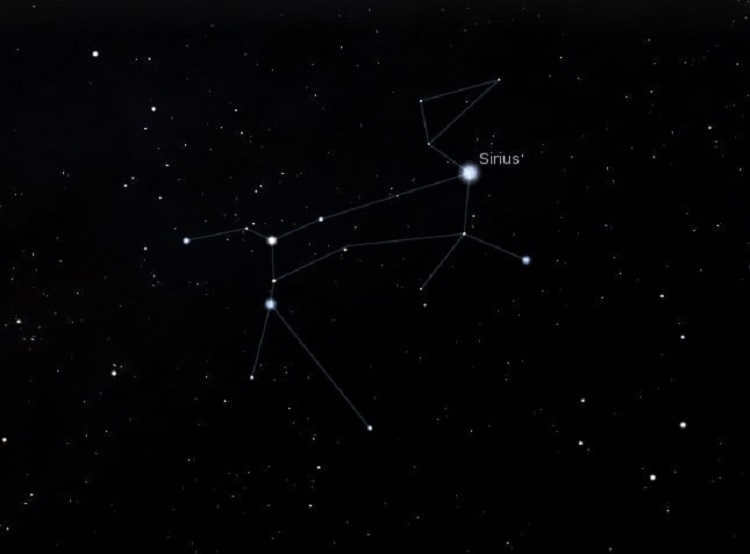
- Constellations
As you may be aware, the constellation known as Big Dog can be found in the Southern Hemisphere. One of its notable characteristics is that it is home to the brightest star in the entire world, Sirius.
When it comes to its position, its neighboring constellations include Unicorn, Dove, Hare, and Corma. In terms of its size, it falls somewhere in the middle. To be more exact, it covers an area of 380 square degrees, making it the 43rd largest constellation.
The distance between the planet Earth and the Big Dog constellation is approximately eight and a half million light years.
When it comes to remarkable stars within the Big Dog constellation, there are several of them that are worth exploring and observing.
Sirius (Alpha of the Big Dog)
It is a binary star with a visible magnitude of -1.42. It is located 8.6 light-years away. Also referred to as the Dog Star, it serves as the brightest star in the night sky and the fifth closest to our solar system.
Interestingly, the star’s dual nature was initially discovered by Friedrich Bessel, a German astronomer and mathematician, in 1844, and he made this discovery through calculations and analysis. He examined numerous observations of this star and detected its slight movement in space, occurring approximately every 50 years. This phenomenon can only be explained by the presence of a relatively massive companion in the system – a second star.
In 1844, Bessel proposed this idea, and in 1862, Alvan Clarke, using his revolutionary 18-inch refractor telescope, successfully identified a second element of Sirius, which became known as Sirius B, or more commonly referred to as the Puppy.
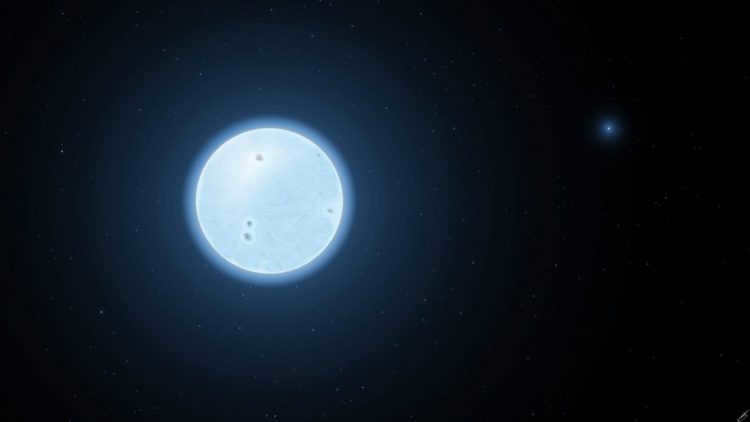
Sirius A is classified as a white main-sequence star, while Sirius B is categorized as a white dwarf that orbits around the primary star approximately every 50 years. The distance between these two celestial bodies can vary from 8.1 to 31.5 astronomical units. Without the aid of professional equipment, it is impossible to observe the companion star.
Currently, it is feasible to observe the binary nature of Sirius using a small telescope, although the brightness of Sirius A makes it challenging to detect the fainter Sirius B. However, when Sirius B is at its farthest distance of 11 angular seconds, it becomes easier to spot.
Sirius A is classified as a spectral type A1V and has a mass approximately twice that of the Sun. On the other hand, Sirius B is a DA2 dwarf with a mass of 0.98 times that of the Sun, making it one of the most massive white dwarfs known. Sirius A has an apparent magnitude of 1.42, whereas Sirius B has an apparent magnitude of 11.18. The age of this stellar system is estimated to be around 200-300 million years.
In Egypt, the Nile flood coincided with the falling of Sirius. The annual flood and summer solstice were important events in the Egyptian calendar during the Celestial Age.
Among the other stars, Rigel (Orion), Aldebaran (Taurus), Capella (Ascendant), Castor (Gemini), and Procyon (Little Dog) create the Winter Hexagon asterism (Winter Circle), which can be seen in the northern sky from December to March.
Sirius is also part of the Winter Triangle (Great Southern Triangle), along with Procyon and Betelgeuse (Orion).
Adara (Epsilon Canis Majoris).
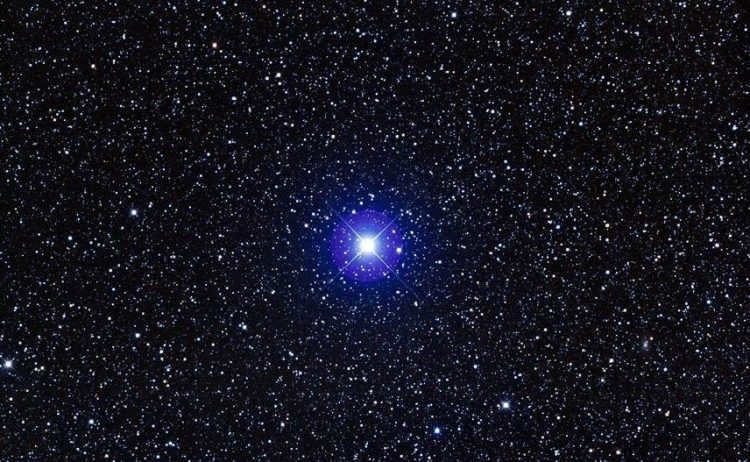
A double star located 430 light-years away. The primary component belongs to the spectral class B2 and has a magnitude of 1.5. It is recognized as one of the most brilliant ultraviolet sources currently known. The secondary star has a magnitude of 7.5 and is positioned at a distance of 7.5" from the primary star.
Within the constellation, it holds the position of the second brightest star and ranks as the 24th brightest star overall. Its name, Adhara, is derived from the Arabic word aðāra, which translates to “virgins”. Approximately 4.7 million years ago, Adhara shone the brightest in the night sky, situated 34 light-years away with a magnitude of -3.99. No other star has achieved such luminosity in the past nor will any other star reach this level of brightness within the next 5 million years.
Wesen (Big Dog Delta) – a unique creature.
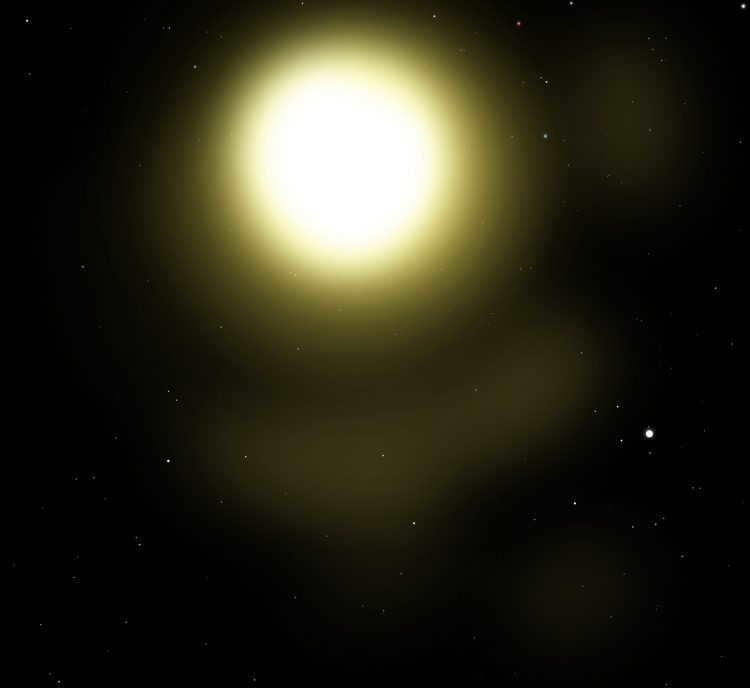
A massive star that shines with a yellow-white glow and is located 1800 light-years away. Its magnitude measures 1.83, making it the third brightest star in the night sky. This celestial body, known as Wesen, can be found approximately 10 degrees southeast of the prominent star Sirius. Its name is derived from the Arabic word “al-wazn,” which translates to “heaviness.” Wesen is estimated to be around 10 million years old, and within the next 100,000 years, it will undergo a transformation into a red supergiant. Eventually, it will explode in a spectacular supernova event.
This is a giant star that shines in a beautiful blue-white color. It has a brightness range of 1.95-2.00 and is located about 500 light years away from us. This particular star belongs to a group known as variable Beta Cepheus stars, which means its brightness varies due to pulsations on its surface. Interestingly, Aludrа, also known as This Big Dog, is visible in the sky before the famous star Sirius.
Aludrа (This Big Dog)
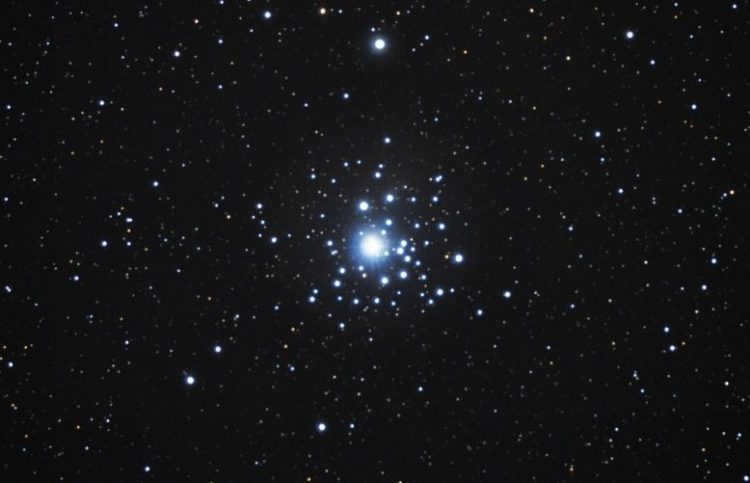
This particular celestial body is classified as a variable star of the Deneb type, boasting a magnitude that fluctuates between 2.38 and 2.48. It is characterized by its striking blue supergiant nature and is situated a staggering distance of 3,000 light years away.
Renowned scientists have conducted extensive research and have come to the conclusion that Aludra is currently undergoing significant changes in its lifecycle. It is anticipated that this star will undergo a supernova event within the next several million years. Interestingly, the name Aludra originates from the Arabic term al-'aðrā, which translates to “virgin” in English.
The Big Dog’s Tau
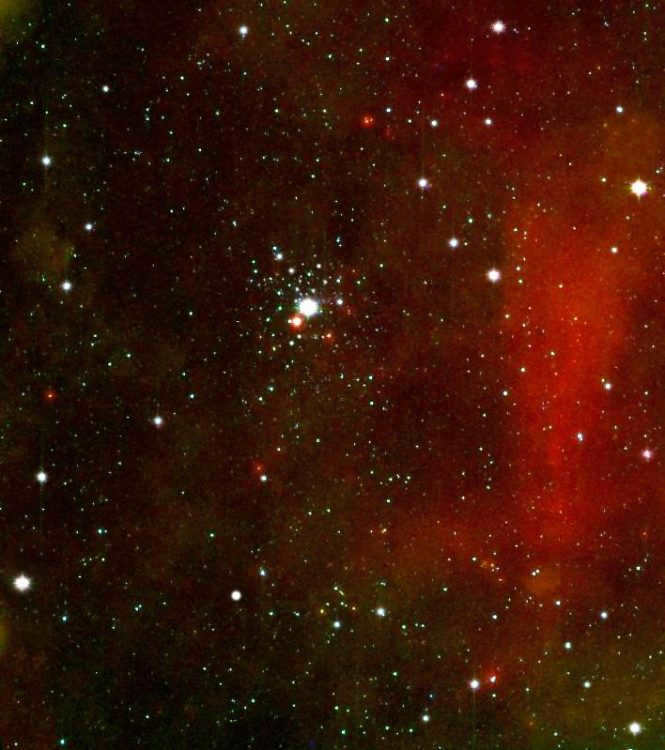
Located 3,200 light-years from Earth, there is a fascinating eclipsing spectroscopic double star. This star holds the distinction of being the brightest one in the open cluster NGC 2362, also known as Caldwell 64.
What makes this star even more intriguing is its classification as an O-type blue supergiant, making it a Beta Lyrae type variable. With a visibility range of 4.32-4.37 and a period of 1.28 days, it continues to captivate astronomers and researchers alike.
Astronomers have discovered a fascinating double star system located 336 light-years away. The primary star, which has a blue-white color and belongs to the B-type main-sequence dwarf category, shines with an apparent magnitude of 3.02. Interestingly, its companion star is completely invisible to us. Despite this, they both revolve around a shared center, completing one orbit every 675 days. The star system is known as Al-furud, a term derived from Arabic that translates to “single.”
Mulifen (Gamma of the Big Dog)
Another intriguing celestial object is Mulifen, also referred to as Gamma of the Big Dog. Situated 402 light-years away, this star is classified as a white-blue B-type giant. Its visible visual magnitude measures at 4.11. Mulifen has a historical name, which originates from Arabic. However, the exact meaning of the name remains unknown.
The reason behind Mulifen being labeled as “gamma” despite its relatively faint appearance is not entirely clear. One possibility is its proximity to Sirius and Mirzam, which might have influenced its designation. Another theory suggests that Mulifen might have been brighter in ancient times. Additionally, there is speculation that the star could be surrounded by a cloud of gas and dust, as it vanished from sight between 1670 and 1693.
Muliphene is rotating at a relatively low speed for a star of spectral class B, with a velocity of only 30 kilometers per second. The star’s luminosity and temperature indicate that it is currently in the final stages of hydrogen burning, and in a few million years, Muliphene will undergo a transformation into a red giant.
Fascinating entities to study
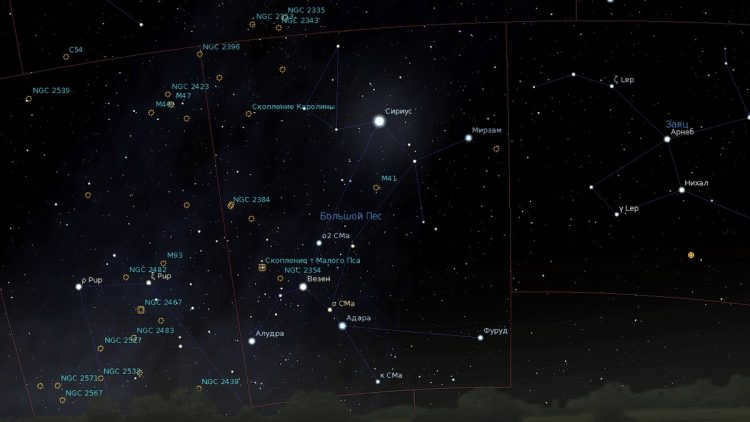
1. M 41 (NGC 2287) – A Dispersed Star Cluster
This dispersed star cluster is predominantly composed of young stars. It is estimated to contain approximately 100 stars, with a total stellar magnitude of 4.6m. The approximate distance from the Sun to this cluster is 2,300 light years.
Another name for this cluster, as mentioned in some sources, is the Small Beehive cluster. It was initially discovered in the 17th century by the Italian astronomer Giovanni Batista Hodiern.
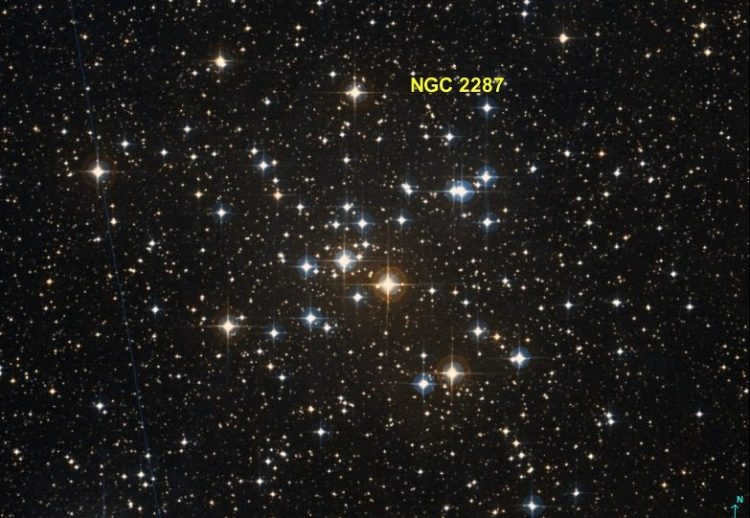
It is simple to locate in the celestial sphere even with binoculars of low magnification. Due to its expansive size measuring approximately 38′ in diameter, it is not advisable to observe it using telescopes as the entire image is unlikely to be visible.
To find it, several methods can be employed, with the most probable and straightforward being to start from the star Sirius and descend slightly eastward towards three stars of 4 star magnitude. From there, continue on a southwest trajectory. A scattering of luminous stars will come into view through the lens. This will be the cluster we are searching for. M 41.
2. Dispersed star cluster NGC 2243
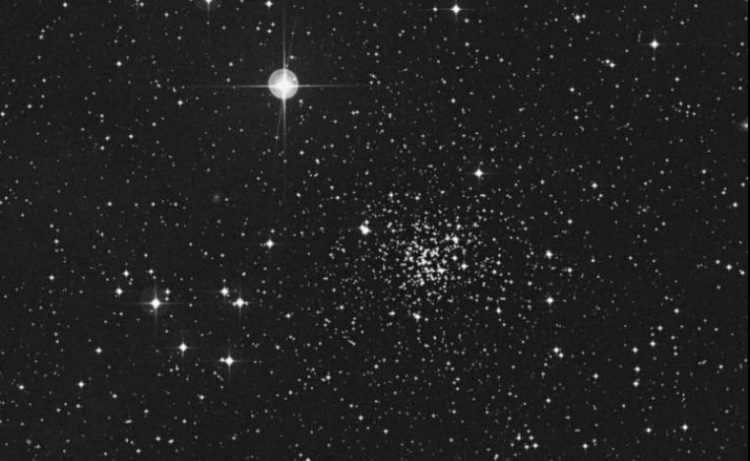
It is additionally a dispersed star cluster. To the naked eye, it appears very dim, revealing only a handful of stars that are encompassed by a faint nebula when observed through a beginner’s telescope. A more detailed examination necessitates the use of larger professional telescopes with a lens diameter of 250 mm or greater.
Due to its faint luminosity, locating it in the sky amidst the multitude of stars is highly challenging. This task is particularly arduous in our latitudes because NGC 2243 is situated very close to the horizon line. Optimal conditions, devoid of urban illumination and other sources of interference, are required.
One approach is to trace a path from the star Wesen and Adara, leading southeast towards stars of magnitudes five or six. Alternatively, one can center on the star Furud and then shift towards the southwest.
3. Dispersed star cluster C 58 (NGC 2360)
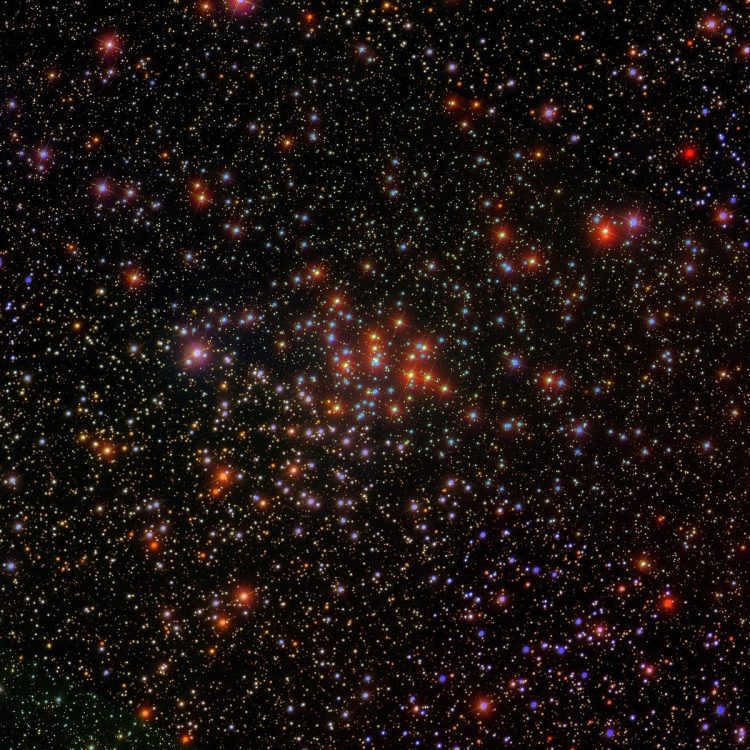
Amateur astronomers and stargazers can enjoy observing this stunning star cluster. With a magnitude of 4.1 m, it showcases around 80 stars ranging in brightness from 8.5 to 12 m. Situated in the same region of the sky as the previously mentioned nebula known as “Thor’s Helmet,” this cluster offers a captivating celestial spectacle.
4. NGC 2345: A Dispersed Group of Stars
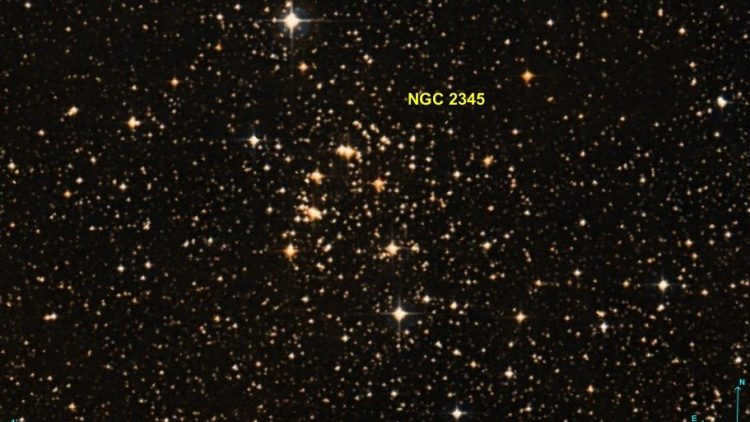

There is another small and dispersed cluster in the upper region of the Big Dog constellation. This cluster has a brightness of 7.7 m and is known as NGC 2345. It can be easily spotted even with binoculars, but for a more detailed view, it is recommended to use a magnification of 35 to 50 times and a wide-angle eyepiece.
These scattered clusters are conveniently located and can be easily found using a finder. To locate them, start by orienting yourself towards the “head” of the Dog and then turn the telescope tube counterclockwise (as shown by the red arrows below):
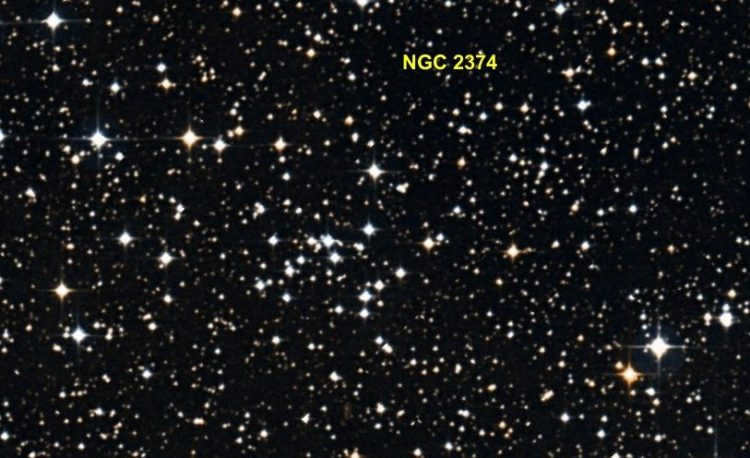
Continuing along the planned path from the previous cluster, we will encounter another cluster, NGC 2374. This cluster, despite being slightly larger in size (19′), has a lower surface brightness (8 m) and is noticeably less contrasting. It can be easily overlooked at first when observing at low magnifications.
In this part of the sky, where the Milky Way stretches across, the density of stars per square degree is exceptionally high, making it challenging to distinguish a dispersed cluster from the surrounding stars.
6. NGC 2362: A Dispersed Star Cluster.
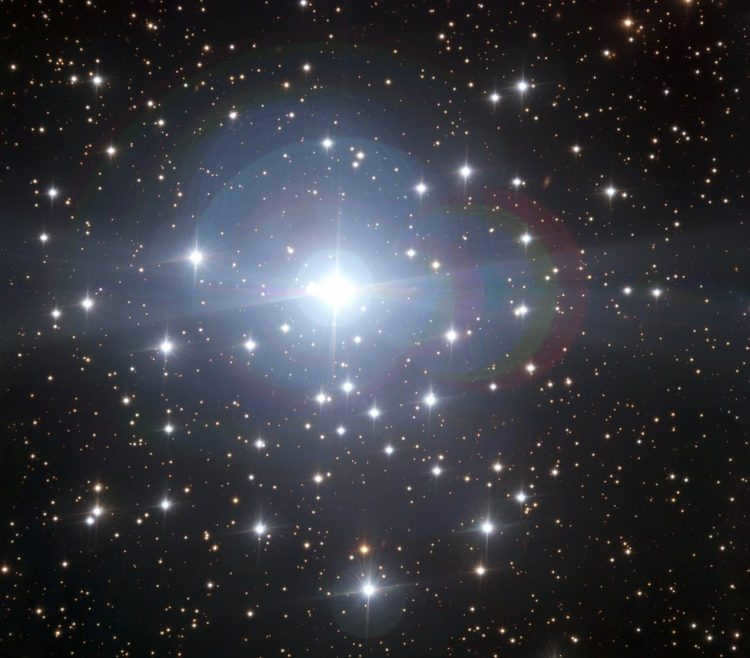
There is another stunning and easily observable star cluster called NGC 2362 (or C 62 according to the Caldwell catalog). This cluster is made up of approximately 60 stars ranging in magnitude from 4 to 12. It has the same brightness as the previous cluster, with a magnitude of 4.1. To observe it, we will need to slightly adjust our position towards the star τ CMa.
7. Dispersed star cluster NGC 2354
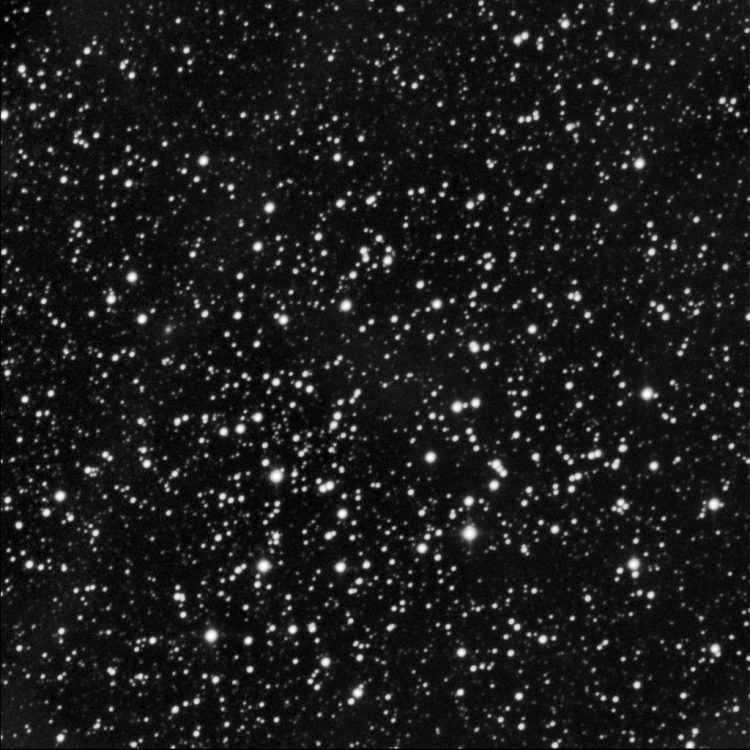
Together with the star cluster NGC 2362 (also known as C 62), there exists an additional dispersed cluster concealed in the tail of Canis Major – NGC 2354. Its dimensions are approximately 20 arcminutes, and its brightness ranges from 6.5 to 7 magnitudes. This cluster can be easily observed using 15x binoculars. When viewed at higher magnifications through a telescope, the most luminous stars (with magnitudes of 9-10) exhibit distinct variations in color.
8. NGC 2367: A Dispersed Star Cluster
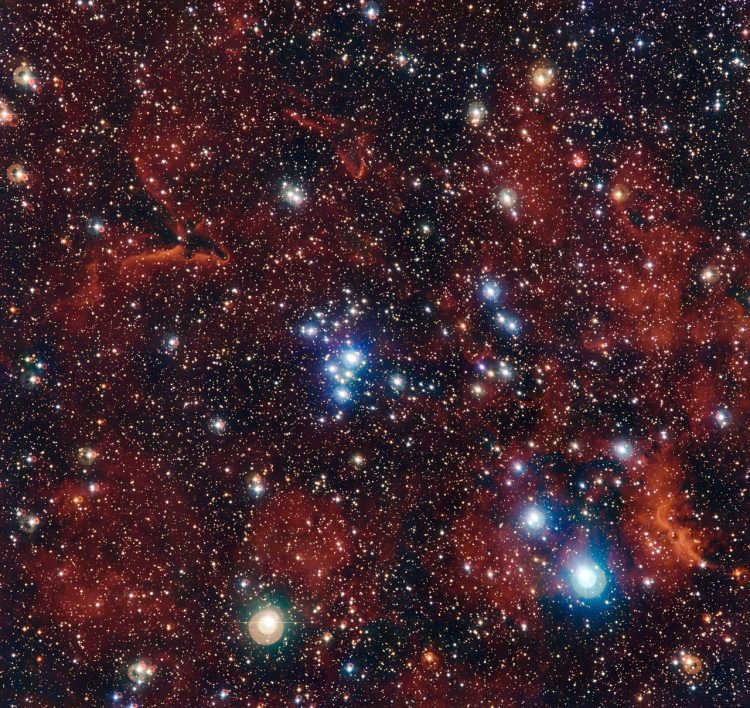
The Big Dog constellation contains another star cluster that is spread out. It has a visible magnitude of 7.9 m. This cluster is quite young, with most of its stars being hot and light blue, with an age of about 5-10 million years. Additionally, the cluster is located within an emission nebula.
To begin your search of the night sky, it is recommended to start from the star Wesen and move westward along a chain of bright stars.
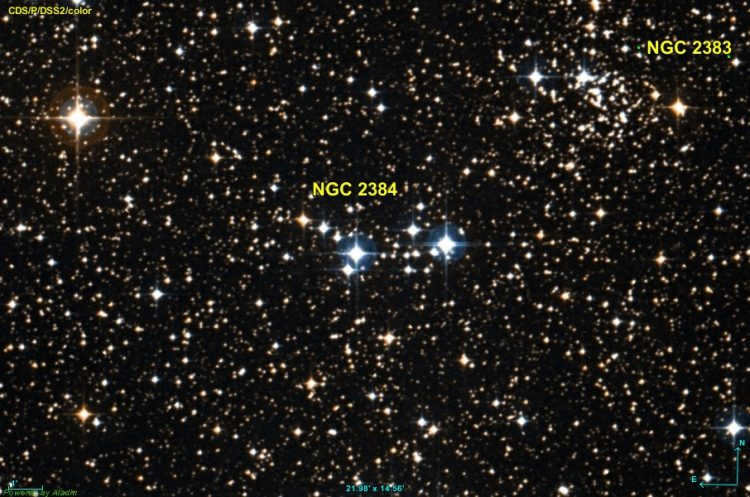
There are two adjacent star clusters that can be observed in close proximity to each other. When looking through an amateur telescope, it is possible to see both of these clusters simultaneously in the lens. The first cluster, known as NGC 2383, is located to the north and has a stellar magnitude of 8.4 m. Just below NGC 2383 is NGC 2384, which has a brightness of 7.9 m. Although the first cluster has a higher number of stars, they have lower brightness and are more challenging to identify. These two clusters can be easily spotted in the night sky, right after the previously mentioned scattered cluster NGC 2367:
10. NGC 2204: A Dispersed Star Cluster
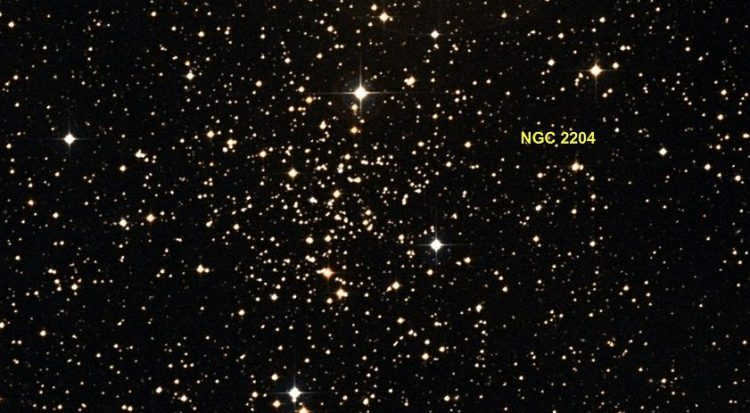
Occupying a small area of only 13 arcminutes and shining with a brightness of 8.6 magnitude, NGC 2204 showcases a highly concentrated core. The majority of its stars have magnitudes of 12 and above, with some of the brightest stars exhibiting distinct spectral colors when viewed at high magnifications (150+). These colors range from the vibrant blue of young stars to the warmer orange hues of older stars.
Finding the cluster is made easier with a low magnification finder or eyepiece, using nearby stars as a reference point. Look for the star Mirceae (β), and follow the direction indicated by the red arrows.
11. Emission Nebula NGC 2359, also known as Thor’s Helmet
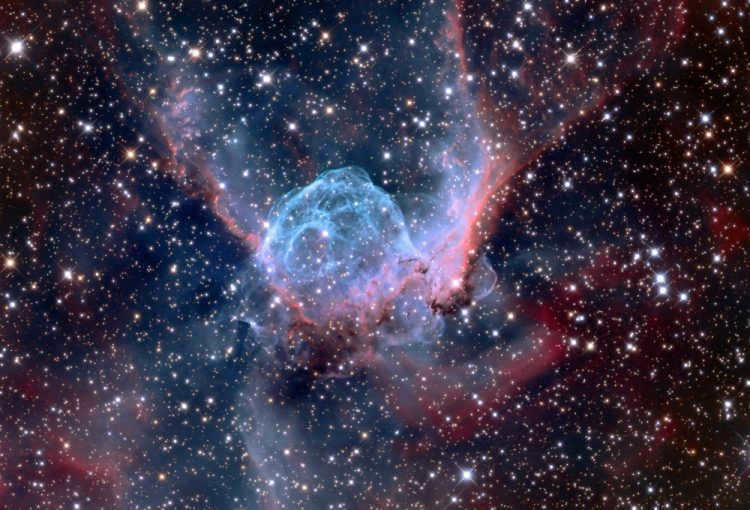
This incredibly stunning nebula is extremely elongated and consequently incredibly dimly illuminated. Nonetheless, I am confident that under optimal atmospheric circumstances, it can be discerned even in amateur telescopes as a hazy amorphous entity. It spans across a distance of 30 light-years and is situated 15,000 light-years away. It took shape around the central Wolf-Rayet star, an immensely scorching colossal celestial body that is poised to undergo a cataclysmic supernova event in the near future.
Spiral galaxy NGC 2217 – a fascinating celestial body.
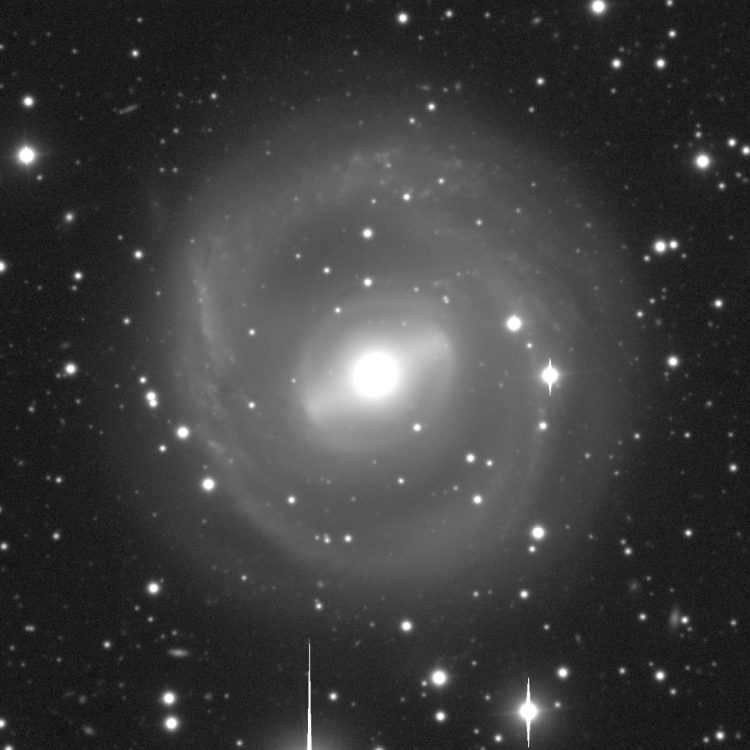
The spiral galaxy NGC 2217 has an apparent stellar magnitude of 10.4. Scientists have observed that the gas in the inner regions of the galaxy moves in the opposite direction of the stars’ rotation. Despite its low surface brightness, it can still be observed using medium-level telescopes with an aperture of 150mm or larger. This is possible because the galaxy’s plane is perpendicular to the Earth observer’s line of sight.
In the night sky, NGC 2217 can be found in the far east, near the border of the Hare and Dove constellations. To locate it, begin your search from the star Furud and head north.
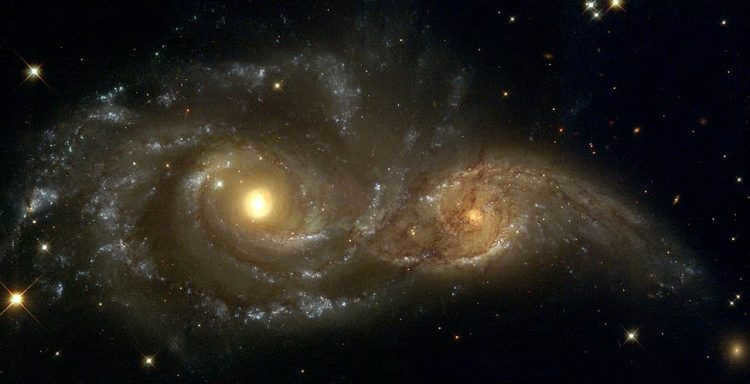
On a clear winter night, the amateur astronomer can observe many interesting features of the unassuming spiral galaxy NGC 2207, which is at a modest 11th star magnitude. All that is required is a powerful 150 mm telescope and no moonlight. These galaxies have a size of just over 4′.
Discovered in 1835 by British astronomer William Herschel, NGC 2207 and IC 2163 make up a pair of actively interacting galaxies. As shown in the photo, the process of galaxy merger has only just begun and will take tens of millions of years before the resulting process can be seen by “future generations”.
To find it, simply start your search with the previous scattered cluster NGC 2204 and lower the telescope tube towards the horizon.
14. NGC 2280 Spiral Galaxy
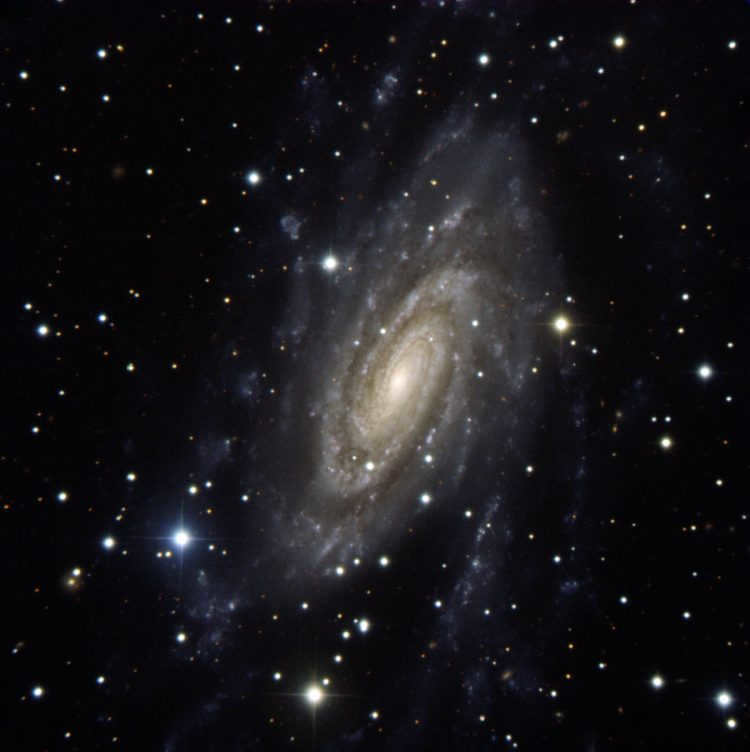
NGC 2280 is classified as a Sc-type spiral galaxy. It has a visual magnitude of 10.5 (although some sources suggest a slightly higher value of up to 12) and measures approximately 6.3′ × 3.0′ in size. Observing this galaxy can be quite challenging due to its nearly edge-on orientation to Earth. NGC 2280 features a prominent core and highly elongated arms. To locate this object, a telescope with an aperture of 200 mm or larger is recommended, with 250 mm being preferred.
15. The Big Dog Star of VY
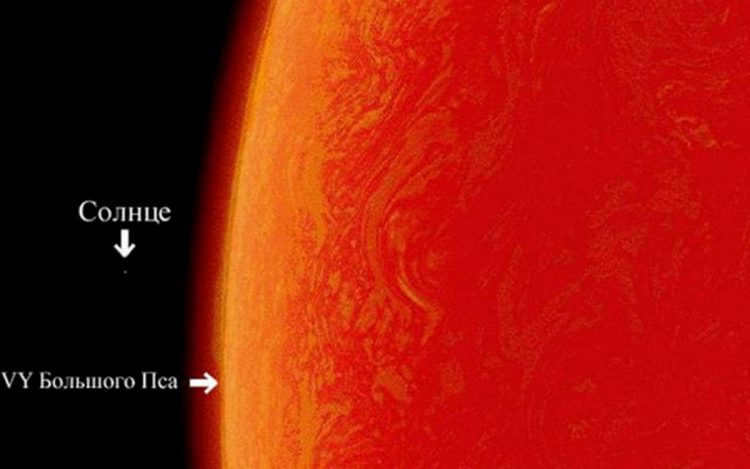
The size of VY compared to the Sun
Above the tail of the Dog, there is a star that is an irregular variable and is known as VY. Its luminosity ranges from 6.5 to 9.4m.
VY is truly one of the largest stars ever discovered. As shown in the image above, VY makes our Sun look like a mere dot. It is almost 1,500 times the diameter of the Sun. Scientists believe that VY is still expanding. This gigantic star is located about 4,000 light-years away from us.
When observed with binoculars, VY exhibits a distinct orange color. However, due to its low luminosity, it is difficult to see any additional details.
Locating the constellation in the celestial sphere
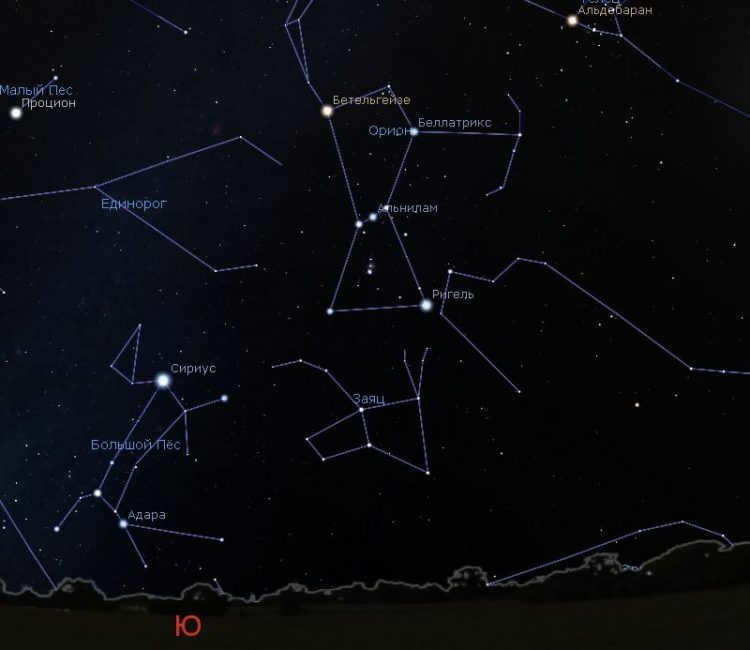
Indeed, the constellation of the Great Canine does not typically require searching for or going unnoticed. The brightest star in the sky, Sirius, with a magnitude of -1.4m, is impossible to overlook. The constellation is situated not far from the Orion constellation, just below and to its left, so it rises later.
If Orion can be observed in October in the middle of the night and in November practically from the evening, the Great Canine appears a bit later, when Orion is already high above the horizon. Therefore, its appearance will not be expected until the end of November or December. There is a reason why the Great Canine is considered one of the winter constellations – it is the ideal time to study it.
Origin of the Enormous Canine
In the distant past, during the era of ancient Egypt, numerous temple priests diligently observed the ascent of Sirius during the early hours of the day. This eagerly anticipated occurrence symbolized the onset of the Nile’s inundation and the arrival of summer, also known as the summer solstice. The ancient Egyptian astronomers referred to this celestial body as Sopt, a name derived from the ancient Greek term “syrios,” which signifies “dazzling.”

Nevertheless, the ancient Romans referred to this celestial body as “canicula,” a term that translates to “dog.” Interestingly, during this time period, summer vacations were not joyous occasions; instead, they were met with fear. This was due to the prevalence of various infections, which were particularly common in Africa. Thus, the appearance of Sirius in the morning not only signaled the start of a vacation but also the potential onset of a deadly fever. It is no wonder that Sirius became known as the Dog Star, and summer became known as the Dog Days.
Therefore, Sirius was a star that inspired both reverence and dread. In fact, this celestial body played a significant role in many ancient religions.
More than 5,000 years ago, ancient Sumerian astronomers, astrologers, and priests made a connection between Sirius and the dog of the sun. This particular star, located in the constellation of the Big Dog, received a great deal of attention and was the subject of many predictions, superstitions, and omens.
In ancient China, Sirius was known as Tien-lang. The ancient Chinese observed a bow and arrow in the southern stars and believed that these weapons were used to kill the “celestial jackal” for attacking the emperor.
Debunking Misconceptions about the Big Dog Constellation
The Big Dog constellation has long been associated with a dog that would accompany the legendary figure of Orion during his hunting expeditions. This constellation is often portrayed as a dog standing upright on its hind legs, chasing after the Hare constellation. In fact, ancient astronomer Manilius even described the Big Dog as a dog with a face that seemed to be on fire, as it held the brightest star, Sirius, in its jaw.
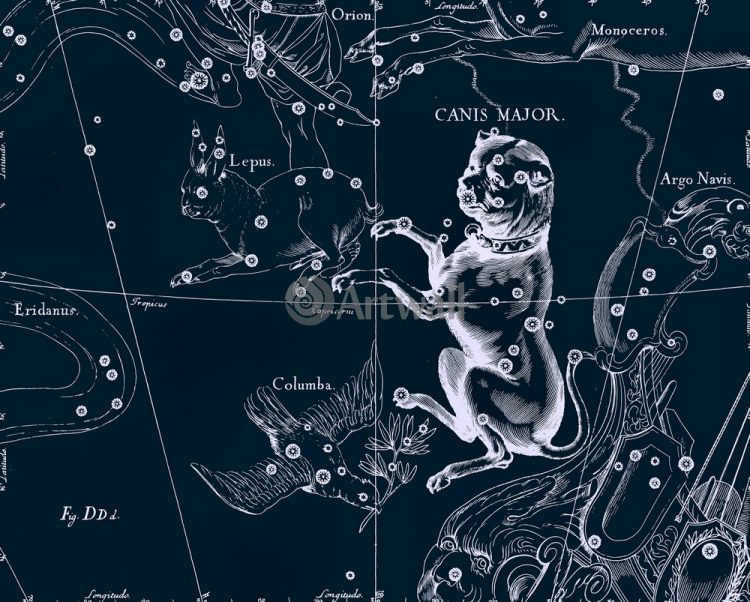
There is a legend that tells the tale of the swiftest canine in existence – the Lelap. This remarkable dog had the ability to catch anything it pursued. It was a gift from Zeus to Europa, along with a spear that never missed its mark. Unfortunately, this gift led to tragedy when Europa’s husband, Cephalus, accidentally killed her while hunting. In an attempt to make amends, Cephalus took Lelap to Thebes to help in catching a troublesome fox that was causing havoc. Just like Lelap, the fox proved to be incredibly fast. They would have chased each other endlessly if Zeus hadn’t intervened and transformed them into stones. Now, Lelap is immortalized in the night sky as a constellation.
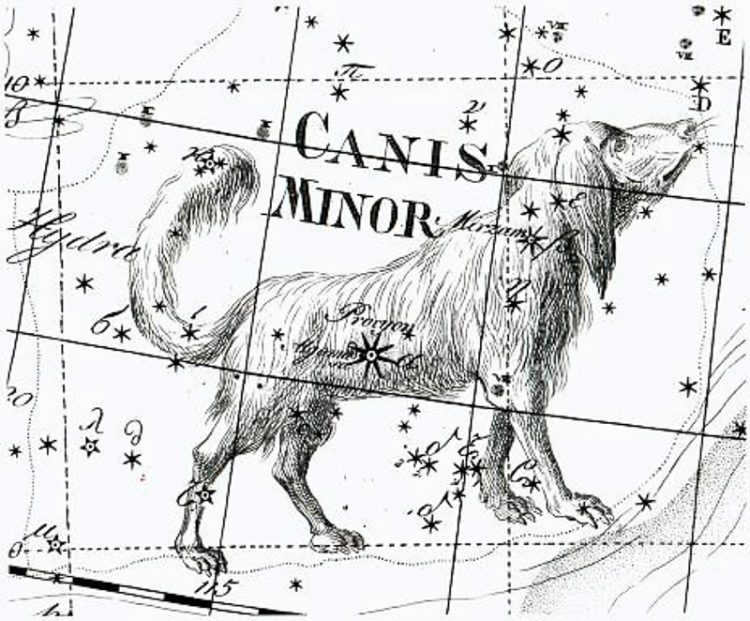
According to a different tale, the deity Dionysus, after being offered hospitality by the shepherd Icarius, graciously taught him the art of winemaking. The shepherd then shared his newfound knowledge with others. When he arrived in Attica, he generously treated the local populace to his wine. However, the townspeople imbibed a bit too much and, suspecting Icarius of foul play, they unjustly executed him and concealed his body in the mountains. The shepherd’s daughter embarked on a quest to find her father, but it was only the loyal dog Myra who was able to locate Icarius. Overwhelmed by grief, the daughter ultimately took her own life. In honor of their tragic fate, the god transformed Icarius, his daughter, and Myra into celestial bodies, giving rise to the three adjacent constellations: Virgo, Canis Major, and Canis Minor.
Watch the Video
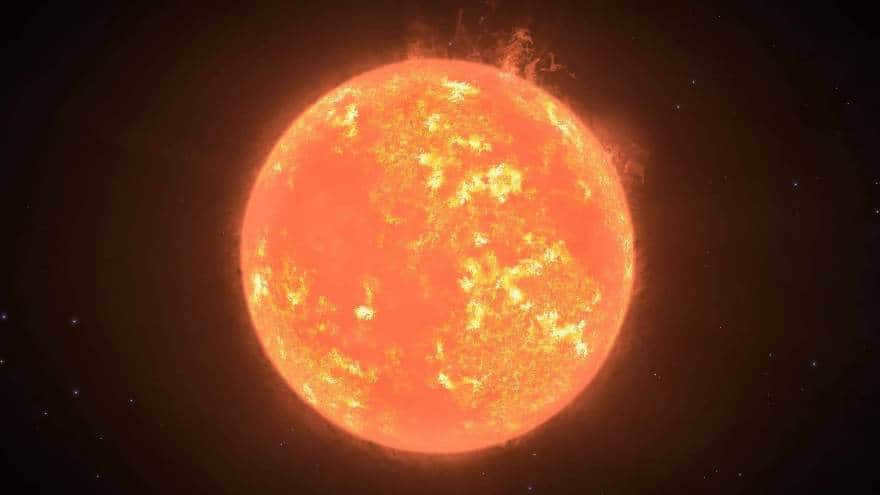
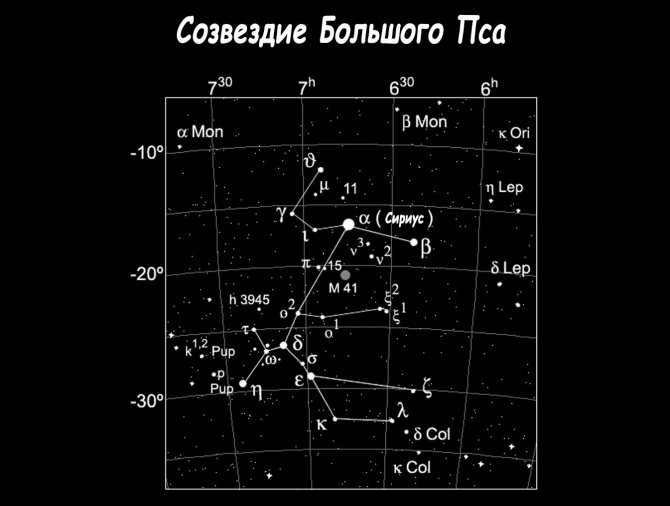
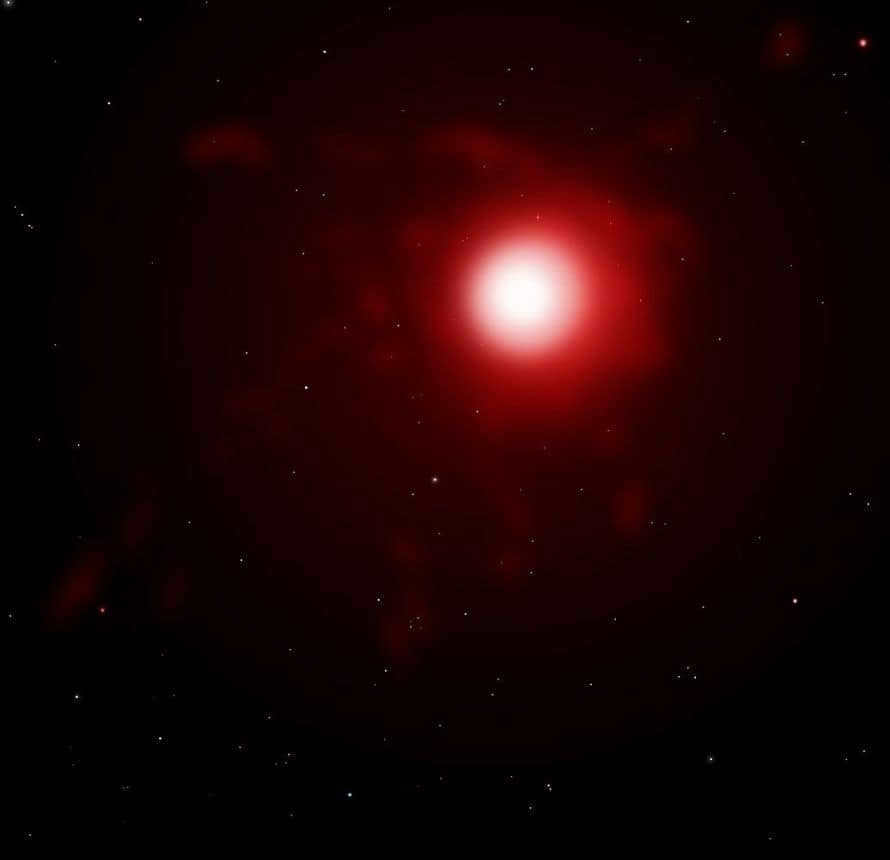
As you are aware, the constellation known as Canis Major is situated in the Southern Hemisphere. Its distinguishing feature is the presence of the incredibly bright star Sirius. In terms of its neighboring constellations, Canis Major is surrounded by Monoceros, Lepus, Columba, and Corvus. In terms of its size, it is considered to be of average magnitude. More specifically, it covers an area of 380 square degrees, ranking it 43rd in size.
- Sirius (α CMa) has a magnitude of -1.46m
- Adara (ε CMa) has a magnitude of -1.5m
- Wesen (δ CMa) has a magnitude of -1.84m
- Mirzam (β CMa) has a magnitude of -1.98m
- Aludra (η CMa) has a magnitude of -2.45m
- Monoceros
- Lepus
- Columba
- Corvus
The distance from planet Earth to Canis Major is approximately eight and a half million light years.
Nature of VY – The Enormous Canine
The initial documented sightings of VY – The Enormous Canine can be found in Joseph Jerome de Lalande’s star catalog dated March 7, 1801, wherein VY SMa is listed as a seventh sidereal magnitude star. Subsequent observations of its apparent stellar magnitude during the nineteenth century indicate that the star has been gradually dimming since 1850[16]
As early as 1847, it was noticed that VY SMa possessed a crimson hue[16]. Multiple discrete components were observed for VY SMa in the nineteenth century, suggesting the possibility that it was a binary star. It is now known that these discrete components are actually bright sections of the nebula encircling the star. Visual observations in 1957 and high-resolution images captured in 1998 revealed that VY SMa does not have a companion star][16]
VY SMa is a star with high luminosity and belongs to the M spectral class. Its effective temperature is approximately 3000 K. It can be found in the upper right section of the Hertzsprung-Russell diagram. The evolution of VY SMa is believed to have been intricate. Prior to transforming into a red supergiant, VY SMa was initially an O-class main-sequence star with a mass ranging from 30 to 40 M☉.
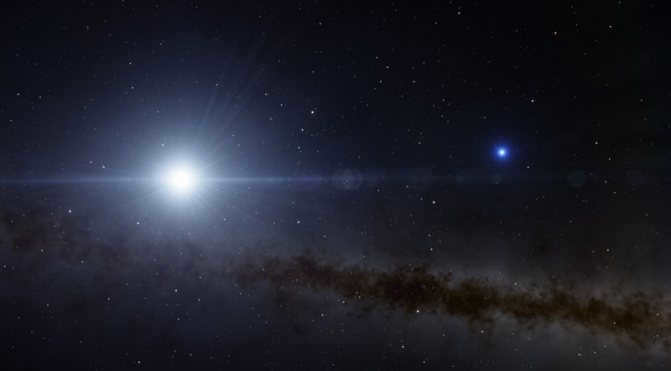
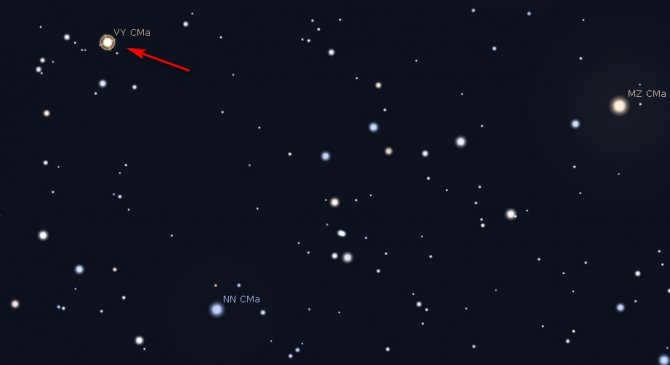
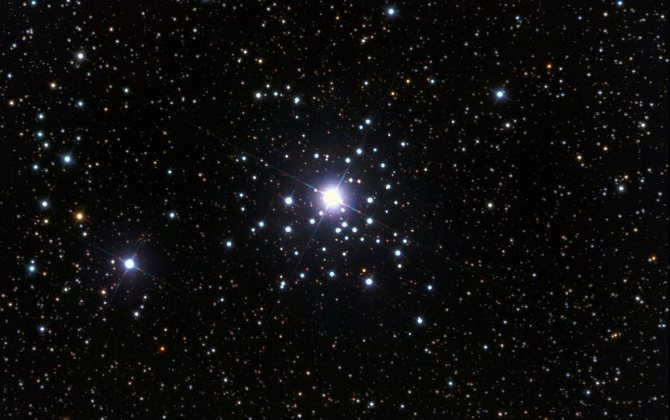
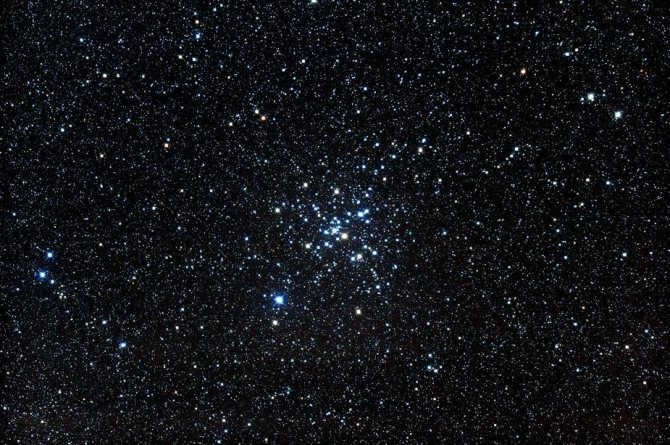
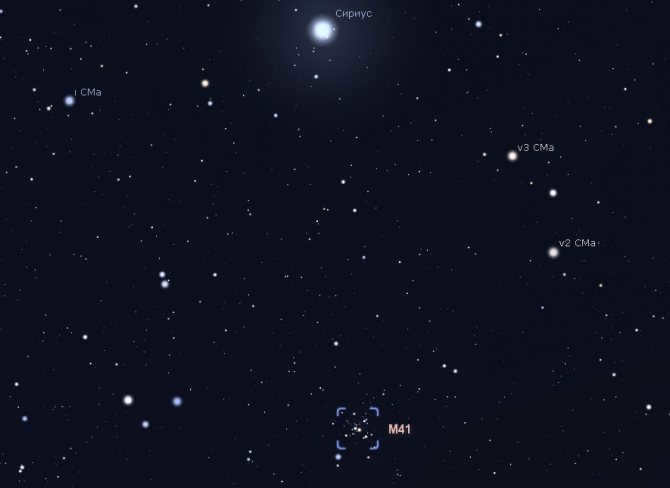
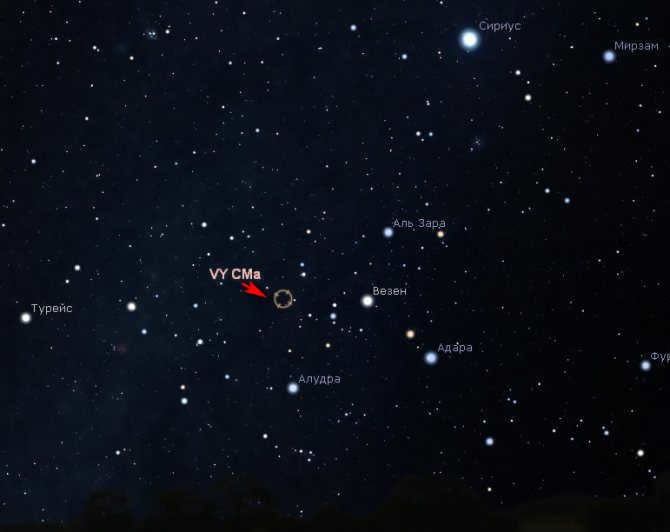
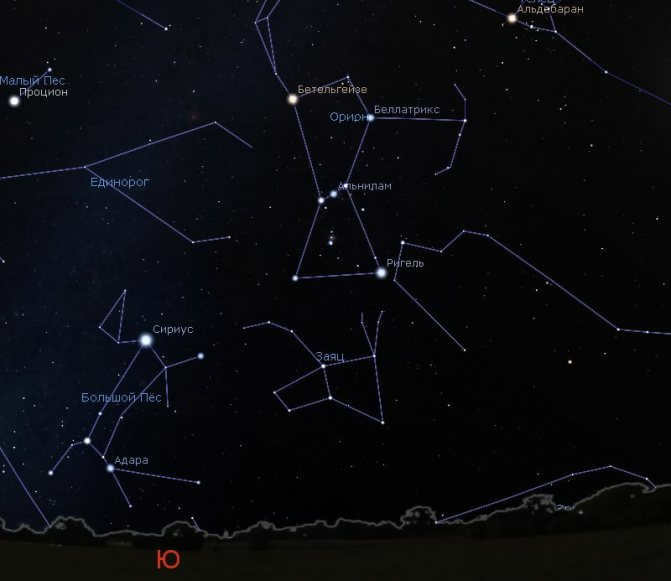

Since the times of Ancient Egypt, the temple priests have been diligently observing the morning rise of Sirius. This highly anticipated occurrence signifies the onset of the Nile’s flooding and the arrival of summer (summer solstice). The ancient Egyptian astronomers referred to this celestial body as Sopt, a name derived from the ancient Greek word “syrios” which translates to “brilliant”.

However, in ancient times, the Romans referred to this star as “canicula,” which translates to “dog.” Interestingly, during this era, summer vacations were not celebrated but rather feared. This was because infections were rampant, especially in Africa. Therefore, the appearance of Sirius in the morning not only signaled a time of rest but also the potential danger of contracting a fever. It is no wonder that Sirius earned its nickname, the Dog Star, and that summer became known as the Dog Days.
Thus, Sirius was not only revered but also feared as a star during ancient times. In fact, this celestial body played a significant role in various ancient religions.
More than 5,000 years ago. The ancient astronomers of Sumer. astrologers and priests connected Sirius with the sun’s dog. It was this star from the Big Dog constellation that received the most attention and became the subject of numerous predictions, superstitions, and omens.
In ancient China. Sirius was known as Tien-lang. The ancient Chinese saw a bow and arrow in the southern stars. According to their legend, it was with these weapons that the emperor killed the “celestial jackal” for attacking him.
Debunking the Myths Surrounding the Great Dog Constellation
One popular misconception about the Great Dog constellation is that it always represents a canine companion to Orion during his hunting expeditions. However, this is not always the case. The Great Dog can also be seen standing on its hind legs, engaged in a chase with the Hare constellation. In fact, the ancient poet Manilius described the Dog as having a face that could set ablaze due to its possession of the brightest star, Sirius, held within its jaws.
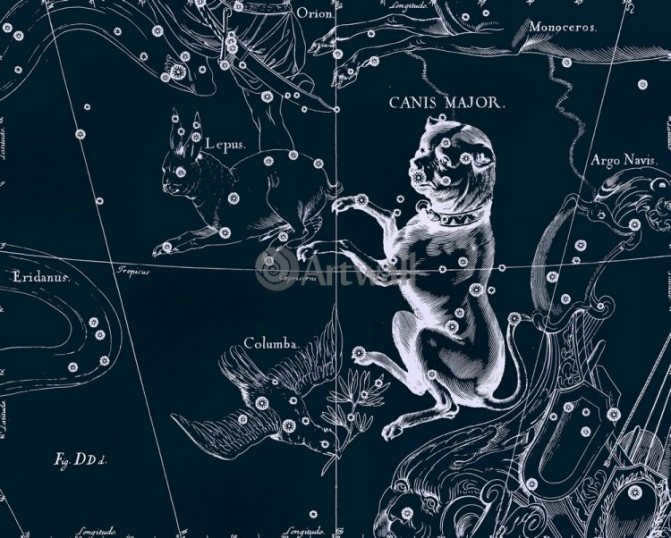
Among the legends, there is also a tale about the swiftest canine on Earth, named Lelap. This remarkable dog possessed the ability to catch anything it pursued. Zeus bestowed Lelap upon Europe, along with a magical spear that never missed its mark. However, this gift proved to be tragic, as Europe’s husband, Cephalus, accidentally killed his wife while hunting. In order to atone for his mistake, Cephalus took the dog to Thebes to capture a troublesome fox that was causing great distress to the locals. Just like Lelap, the fox displayed astonishing speed. The chase seemed endless, until Zeus intervened and transformed both Lelap and the fox into solid rocks, forever preserving their incredible swiftness. Today, Lelap can be seen among the stars, immortalized as a constellation in the sky.
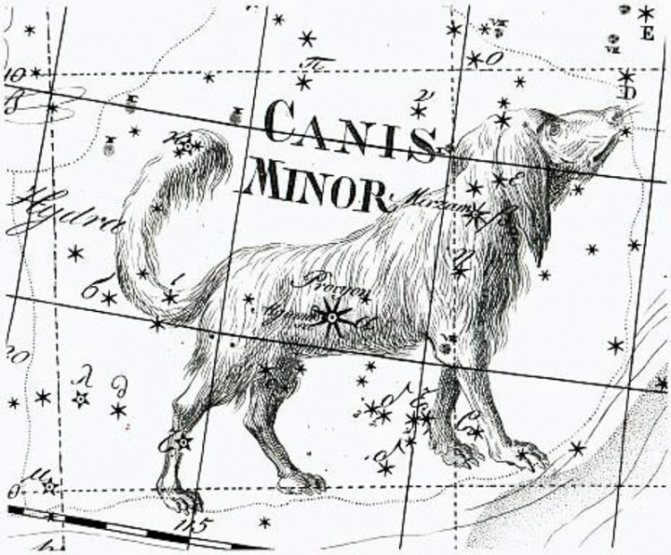
According to an alternative tale, the deity Dionysus, after being given shelter by the shepherd Icarius, graciously imparted his knowledge of winemaking to him. In turn, the shepherd shared this newfound expertise with the local community upon his arrival in Attica, offering them a taste of the exquisite beverage. Unfortunately, the townspeople consumed the wine to excess and, in their intoxicated state, mistakenly believed that Icarius had poisoned them. Tragically, they executed him and concealed his lifeless body in the nearby mountains. For an extended period of time, the shepherd’s daughter tirelessly searched for her beloved father, but it was only a faithful canine companion named Myra who was able to locate Icarius.
Overwhelmed by grief and unable to bear the loss, the young girl ultimately took her own life. In a fit of anger, Dionysus unleashed a series of afflictions upon the inhabitants of Attica, while simultaneously transforming the shepherd Icarius, his daughter, and the loyal dog Myra into celestial bodies. Thus, three interconnected constellations were formed: Virgo, Canis Major, and Canis Minor.
Also check out: View the Sun live online (NASA). Real-time solar activity. Photo of the star today from a satellite
Watch
Measuring Distances
The distances to stars can be calculated by observing the parallactic shift of the star, which is caused by the change in the observer’s position in relation to it due to the Earth’s orbit around the Sun. However, the parallax value of VY CMa is too small to be within the margin of error, which makes this method of determining distance unreliable[17]
In 1976, Charles J. Lada and Mark J. Reed made a groundbreaking discovery when they announced the finding of a luminous halo of molecular cloud located 15 arc minutes to the east of VY CMa. The border of this cloud is adjacent to the bright rim of the star. Scientists were particularly intrigued by the sudden increase in brightness of the emission, coupled with a decrease in gas emission, which led them to conclude that this cloud is a component of the NGC 2362 nebula and is positioned at the same distance as nearby stars, specifically 1.5±0.5 kiloparsecs as determined from the Hertzsprung-Russell diagram[10]
VY CMa is projected onto the apex of the molecular cloud’s rim, indicating a potential association between the two. Furthermore, the velocity of the molecular cloud closely matches that of the star, reinforcing the notion that this star is indeed linked to the molecular cloud and, consequently, to NGC 2362. This implies that VY CMa is also situated at a distance of 1.5 kiloparsecs]
Locating a star formation in the celestial sphere
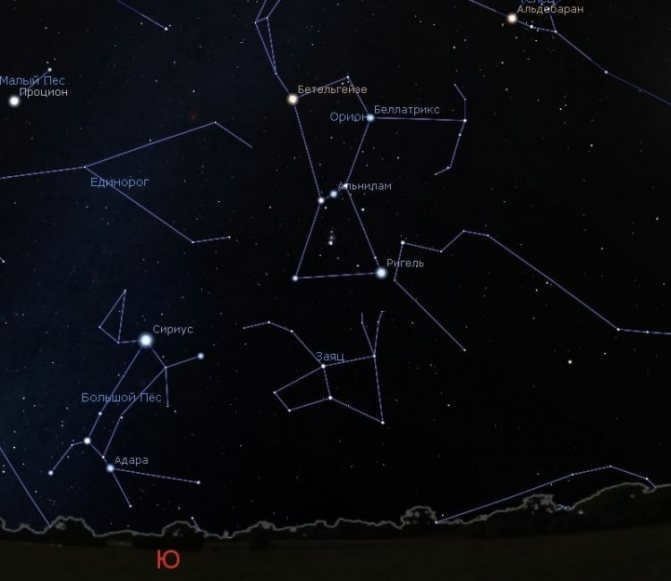
It’s true that the constellation of the Big Dog is not typically one that people actively seek out, but it’s hard to miss the presence of Sirius, the brightest star in the sky with a magnitude of -1.4m. The Big Dog is situated in close proximity to the Orion constellation, located below and to the left, so it rises later.
While Orion can be observed as early as October in the middle of the night, and in November it can be seen practically from the evening, the Big Dog makes its appearance a bit later. By the time Orion is already high above the horizon, which is the end of November or December, the Big Dog will start to become visible. The reason why the Big Dog is considered a winter constellation is because that is the optimal time to study it.
Sirius can be easily identified as it is situated in a nearly straight alignment with the three stars of Orion’s belt, albeit slightly lower. There is no mistaking Sirius for any other star. Once you have located Sirius, it becomes a simple task to locate the other stars that make up the constellation.
Dimension
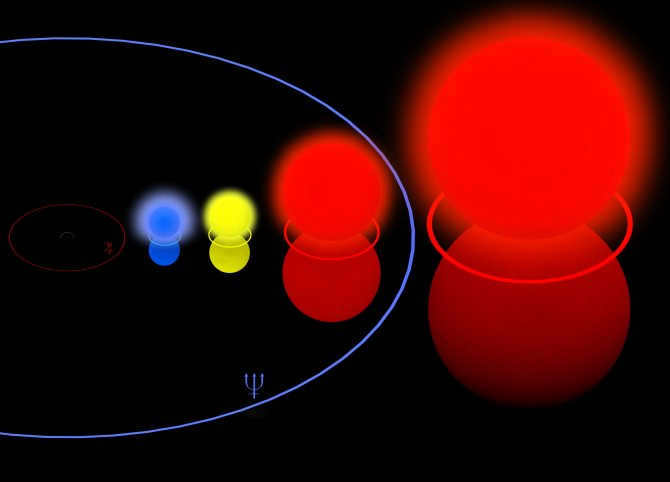
From left to right: The VY SMa star is compared to Betelgeuse, Rho Cassiopeia, the Pistol star, and the Sun (which is too small to be seen in this picture). The red orbit represents Jupiter, while the blue orbit represents Neptune.
According to Professor Robert M. Humphries from the University of Minnesota, the radius of VY SMa is estimated to be between 1800 and 2100 times the radius of the Sun. If this star were in place of the Sun, its surface would extend beyond the orbit of Saturn, which is approximately 9 astronomical units away. Taking into consideration the upper limit of VY’s radius at 2100 solar radii, it would take more than 8.5 hours for light to travel around it. In comparison, it only takes 14.5 seconds for light to travel around the Sun at the speed of light. The volume of VY SMa is approximately 7-1015 times larger than the volume of the Earth.
If we were to represent the Earth as a small ball with a diameter of just one centimeter, then using the same scale, the diameter of VY SMa would be a massive 2.3 km. Furthermore, it is estimated that VY SMa has a radius of 2,100 times that of the Sun.
Additionally, you may be interested to know that the 25th cycle of solar activity has recently commenced. This is of particular significance as it aligns with A.L. Chizhevsky’s theory regarding solar-terrestrial connections. This theory explores the nature of rebellion and its potential links to solar phenomena.
The Big Dog constellation is the 43rd largest constellation among all 88 constellations on the celestial sphere, covering an area of 380 square degrees. It can be easily observed in latitudes ranging from +57° to -90°. The ideal time for viewing this constellation in Belarus, Russia, and Ukraine is from mid-December to the end of January. While it belongs to the southern hemisphere, residents of the northern hemisphere can still enjoy clear visibility of this constellation during the winter months.
The Big Dog constellation showcases 4 prominent stars with a magnitude of less than 3. These stars include Sirius (-1.45m), Adara (1.5m), Mirzam (1.90m), and Wesen (1.95m).
Adjacent constellations that can serve as useful landmarks in navigating the night sky include Unicorn, Hare, Dove, and Corma.
The Big Dog is commonly abbreviated as CMa in reference books, and its full Latin name is Canis major.
Controversy
Dispute
There has been a lot of controversy surrounding the issue.
Conflict
Debate
There has been a great deal of conflict surrounding the matter.
Contestation
Disagreement
There has been a considerable amount of contestation surrounding the topic.
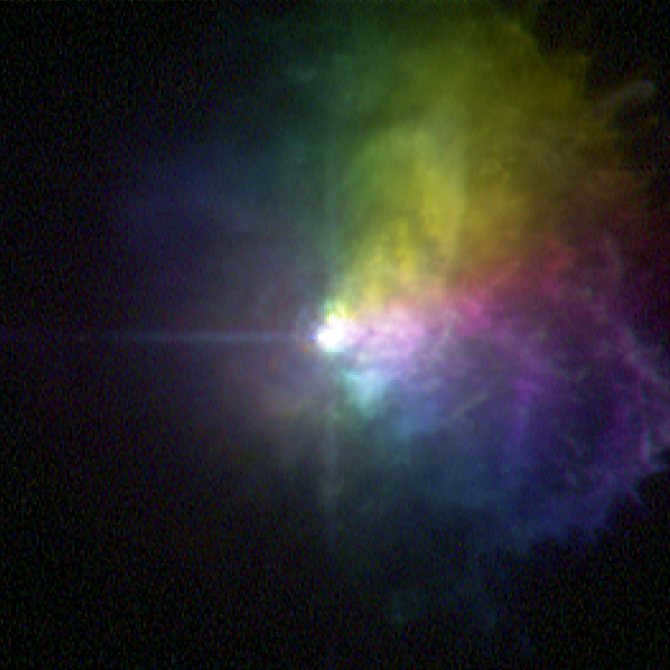
VY of the Big Dog releases massive quantities of gas during its eruption[19].
There are two conflicting opinions regarding the characteristics of VY CMa. According to one perspective, this star is an extremely large and intensely red luminous hypergiant. According to other viewpoints[20], it is a typical red supergiant with a radius of approximately 600 solar radii.
In addition to its size, the luminosity of VY CMa is also a subject of debate. Humphreys highlights that visual photometry, when processing visual and red fluxes in the thermal infrared range of the spectrum, is inadequate for stars with significant amounts of circumstellar dust.
VY of the Big Dog also showcases the challenges in determining the “outer layer” (and size) of extremely massive stars. With an average density ranging from approximately 0.000005 to 0.000010 kg/m³, the star is thousands of times less dense than the Earth’s atmosphere (air) at sea level. While considering the size of our Sun, its radius never encompasses the corona, whereas the corona of the Sun is hotter and denser than the “outer layer” of VY of the Big Dog. As a result, the precise radius of the star remains unknown.
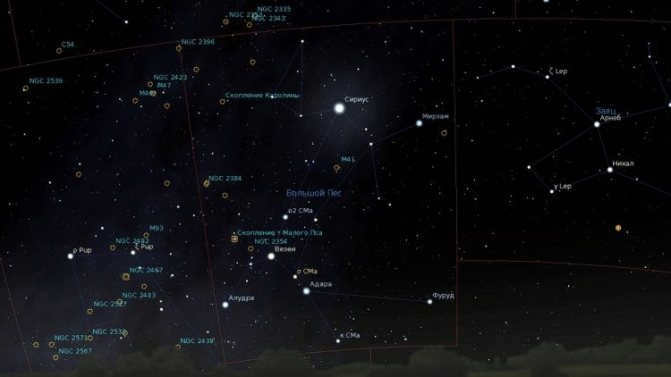
Scattered star cluster M 41 (NGC 2287)
This dispersed group of stars is primarily composed of youthful stars. It is believed to contain around 100 stars. The total magnitude of its stars is 4.6m. The approximate distance from the Sun is 2,300 light years.
Alternatively referred to as the Small Beehive cluster, this cluster was discovered in the 17th century by Italian astronomer Giovanni Batista Hodiern.
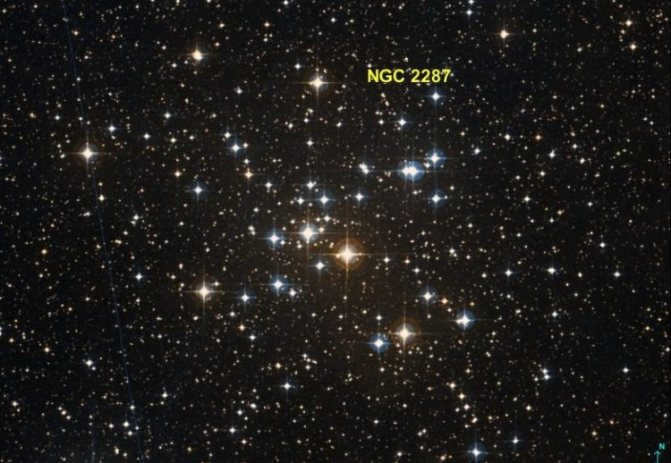
It is simple to locate in the sky, even with low-magnification binoculars. Due to its large size, with a diameter of approximately 38′, it is not recommended to observe with telescopes, as the entire image may not be visible.
There are various ways to find it, but the most likely and easiest method is to start from the star Sirius and move slightly eastward to three stars of 4th magnitude. Then, continue on a southwest path. In front of us, a scattering of bright stars will come into view. This will be our desired cluster, known as M 41.
Scattered star cluster NGC 2243 is a stunning celestial formation.
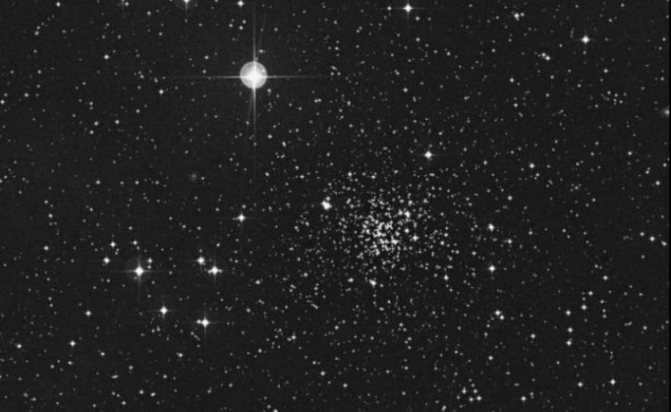
This celestial body is also classified as a dispersed star cluster. Its faint luminosity makes it challenging to observe in an amateur telescope, as only a few stars can be seen, surrounded by a subtle nebula. To obtain a more detailed view, large professional telescopes with a lens diameter of 250 mm or greater are required.
Due to its dim brightness, locating this cluster among the vast expanse of stars in the sky can be quite difficult. This task becomes even more challenging in our latitudes, as NGC 2243 “lies very low, near the horizon line. Perfect conditions, free from city lights and other sources of interference, are necessary.
One approach to finding this cluster is to track from the star Wesen, Adara, and continue southeast towards stars of magnitudes five or six. Alternatively, one can focus on the star Furud and move in a southwest direction.
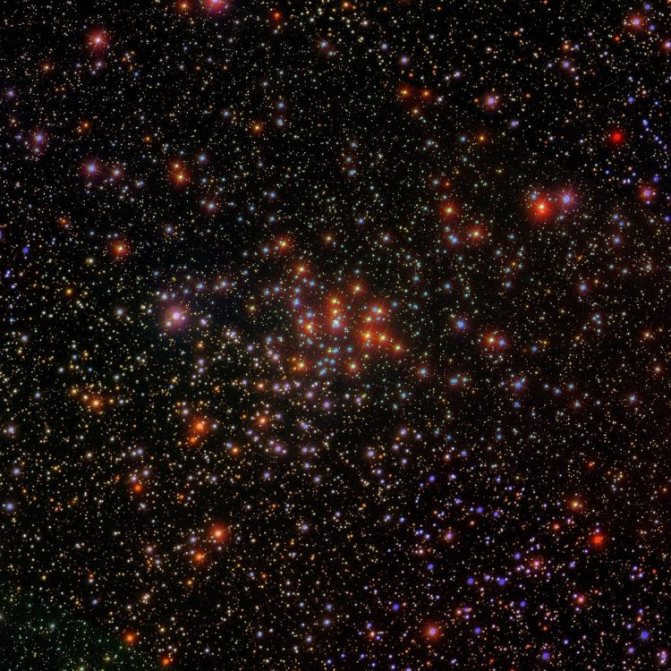
This stunning group of stars can be seen using amateur telescopes and binoculars. It has a magnitude of 4.1m. The cluster consists of approximately 80 stars ranging in brightness from 8.5 to 12m. It is situated in the same part of the sky as the previously mentioned nebula, known as “Thor’s Helmet.”
NGC 2345: A Distant Star Cluster Spread Across the Sky
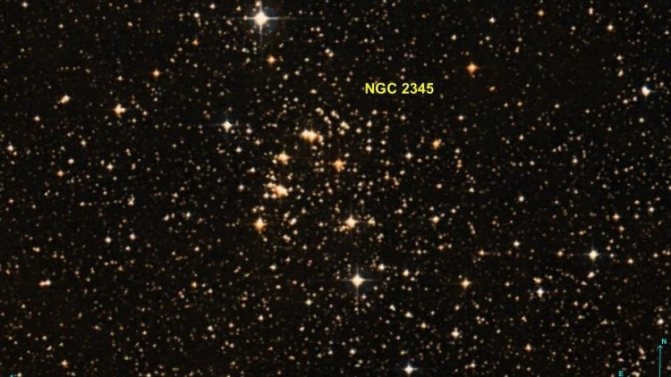
Located at the top of the Canis Major constellation, there is another small and scattered cluster measuring 12 feet in size. This cluster, known as NGC 2345, has a brightness of 7.7m and can be easily spotted even with binoculars. However, for a more complete view and to observe larger details, it is recommended to use a magnification of 35 to 50 times and a wide-angle eyepiece.
Scattered clusters like this one are conveniently positioned in the finder. To locate it, simply orient yourself towards the “head” of the Canis Major and then rotate the telescope tube counterclockwise as indicated by the red arrows below:
NGC 2374: A Dispersed Cluster of Stars.
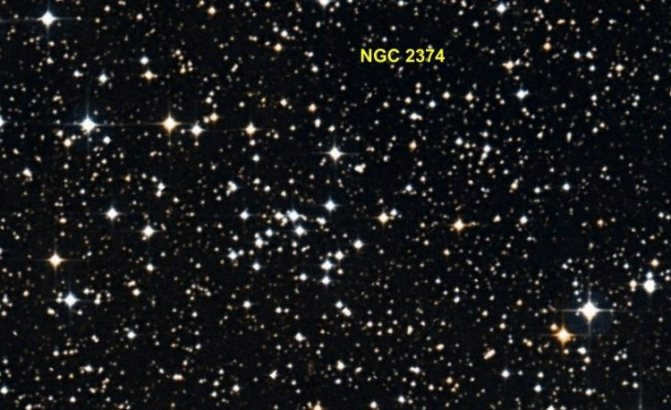
Continuing on the planned route from the previous cluster, we will encounter another cluster similar to NGC 2345 – NGC 2374. While NGC 2374 is slightly larger in size (19′), it has a lower surface brightness (8m) and is noticeably less distinct. It is possible to overlook this cluster at first when observing at low magnifications.
The density of stars in this area of the sky, where the Milky Way band is located, is extremely high, making it challenging to distinguish a scattered cluster from the surrounding stars.
NGC 2362: A Dispersed Star Cluster in the Night Sky
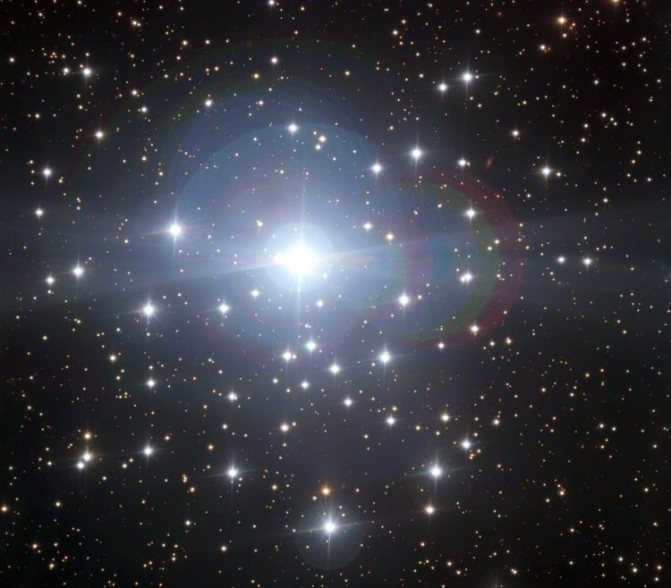
There is another star cluster called NGC 2362 (or C 62 in the Caldwell catalog) that is also beautiful and can be easily observed with simple telescopes and binoculars. This cluster consists of approximately 60 stars with magnitudes ranging from 4 to 12. The cluster has the same brightness as the previous one, which is 4.1m. To observe NGC 2362, we need to move slightly downwards to the star τ CMa.
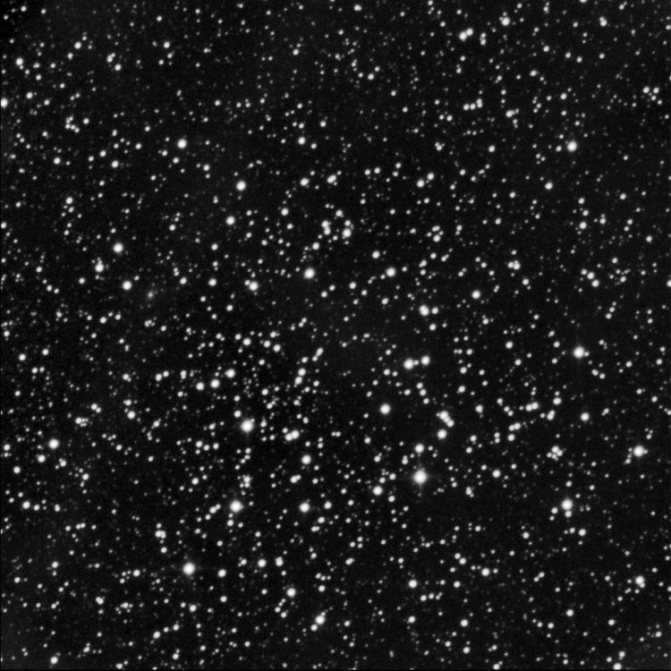
Together with the group NGC 2362 (also known as C 62), there exists another dispersed group concealed in the tail of Canis Major – NGC 2354. It measures approximately 20 arcminutes in size and has a brightness of about 6.5 magnitude (sometimes it is recorded as 7 magnitude). This group can be easily observed using 15x binoculars. When viewed at higher magnifications through a telescope, the most luminous stars (with a stellar magnitude of 9-10) display distinct variations in color.
The scattered star cluster NGC 2367
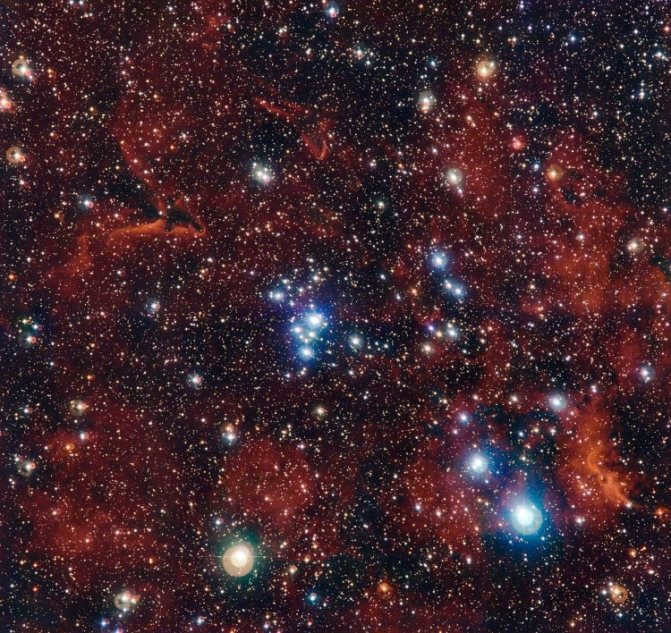
There is another dispersed group of stars located in the constellation of Canis Major. It possesses a visible magnitude of 7.9m. This cluster is relatively young, with most of its stars being hot and light blue, approximately 5-10 million years old. Additionally, the cluster is surrounded by an emission nebula.
For those interested in observing this cluster, it is recommended to begin by locating the star Wesen and then proceed westward along a series of bright stars.
A duo of dispersed star clusters NGC 2383 and NGC 2384
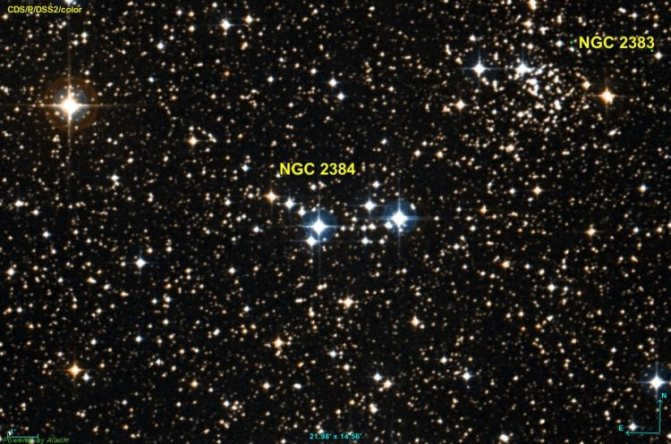
There are two adjacent star clusters that can be observed in close proximity to each other. When observing through a telescope, it is possible to see both of these clusters at the same time. The first cluster, NGC 2383, is located to the north and has a star magnitude of 8.4m. Just below it is the second cluster, NGC 2384, with a star magnitude of 7.9m. Although the first cluster contains a greater number of stars, they are less bright and more challenging to identify. This pair of clusters can be spotted in the night sky immediately after the preceding scattered cluster, NGC 2367.
Dispersed star grouping NGC 2204
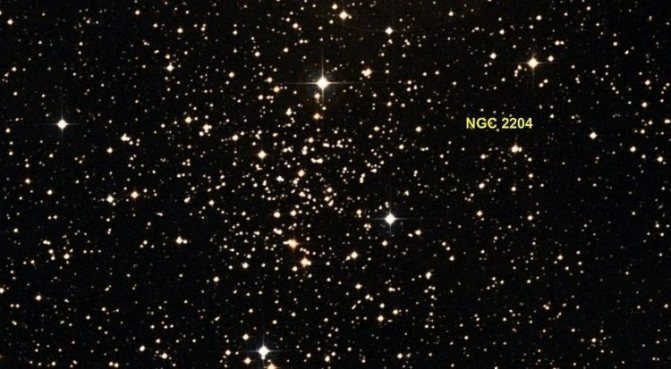
With a small area of 13′ and scattered clusters, and a brightness of 8.6m, NGC 2204 has a core that is very saturated. The majority of the stars in the cluster have a stellar magnitude of 12 and above. When viewed at high magnifications (150+), it is possible to clearly distinguish the spectral colors of some of the brightest stars, ranging from young bright blue stars to older cool orange stars.
The cluster can be easily located using a finder or an eyepiece with low magnification, using a nearby star as a reference point. The direction is marked by red arrows pointing towards Mirceae (β).
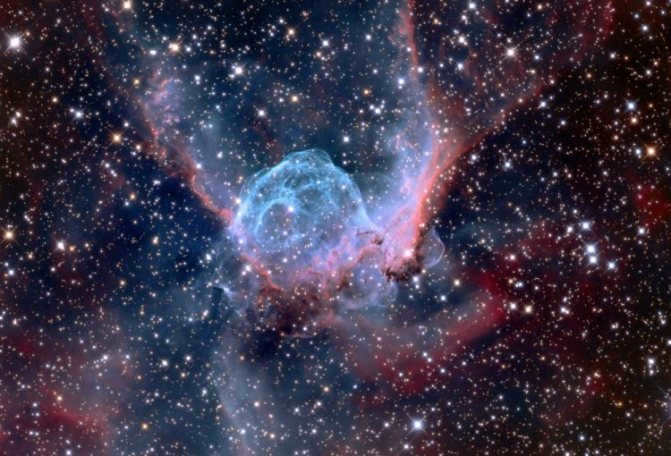
The nebula is incredibly stunning and has a remarkably elongated shape, which gives it a faint luminosity. However, I am confident that, given optimal atmospheric conditions, it is possible to observe this nebula even with a basic amateur telescope, appearing as a hazy and undefined object. Spanning across a distance of 30 light-years and situated approximately 15,000 light-years away, this nebula is encircling a central Wolf-Rayet star – an immensely hot and massive star that is on the brink of a cataclysmic supernova explosion.
NGC 2217: An Exquisite Spiral Galaxy
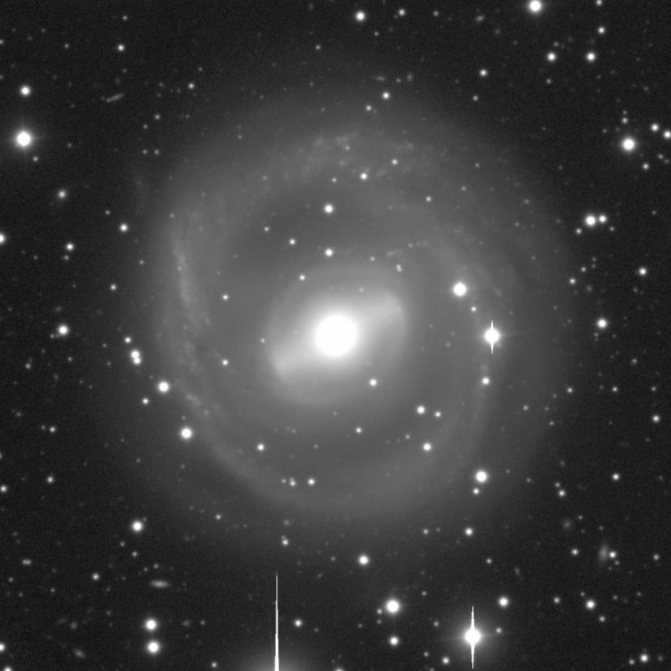
The spiral galaxy NGC 2217 has an apparent magnitude of 10.4m. Scientists have observed that the gas in the inner regions of the galaxy moves in the opposite direction of the stars’ rotation. Despite its low surface brightness, it can still be observed with medium-level telescopes that have an aperture of 150mm or larger. This is possible because the galaxy’s plane is perpendicular to the Earth observer’s line of sight.
In the sky, NGC 2217 can be found in the easternmost part of the border between the constellations Hare and Dove. To locate it, start from the star Furud and move in a northerly direction.
The galaxy NGC 2207 with a spiral shape

On a clear winter night, the amateur astronomer can observe many fascinating features of the unassuming spiral galaxy NGC 2207 with a powerful 150 mm telescope and no moonlight. The galaxies have a size of just over 4′.
Discovered by English astronomer William Herschel in 1835, this is a pair of actively interacting galaxies (NGC 2207 and IC 2163). As shown in the photo, the process of galaxy merger is in its early stages, and it will take millions of years for the resulting process to be visible to future generations.
To locate it, simply start your search from the previous scattered cluster (NGC 2204) and gradually lower the telescope tube towards the horizon.
NGC 2280: A Mesmerizing Spiral Galaxy
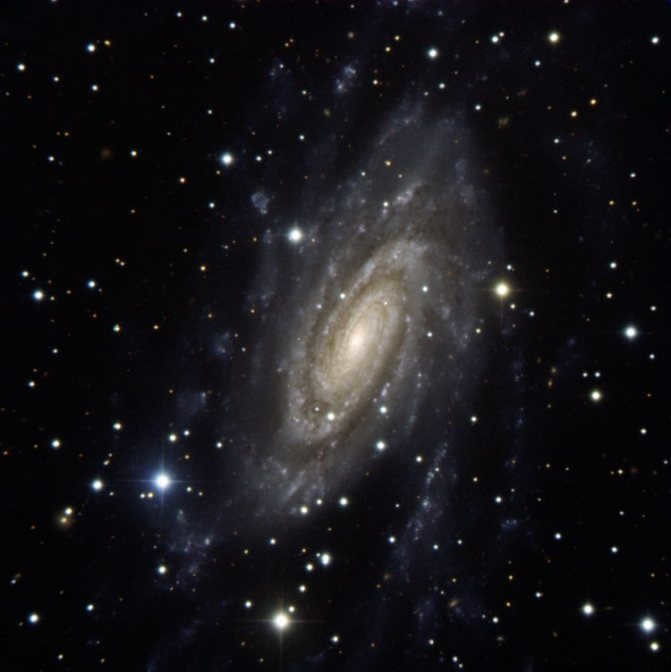
NGC 2280 is classified as a Sc-type spiral galaxy. It has a magnitude of 10.5m (although some sources suggest it may be slightly higher, reaching up to 12 star magnitude) and measures about 6.3′ × 3.0′ in size. Observing this object can be extremely challenging as it appears almost edge-on to the viewer. It features a compact core and very elongated arms. To locate NGC 2280, a telescope with an aperture of at least 200 mm is required, with a recommended aperture of 250 mm or larger.
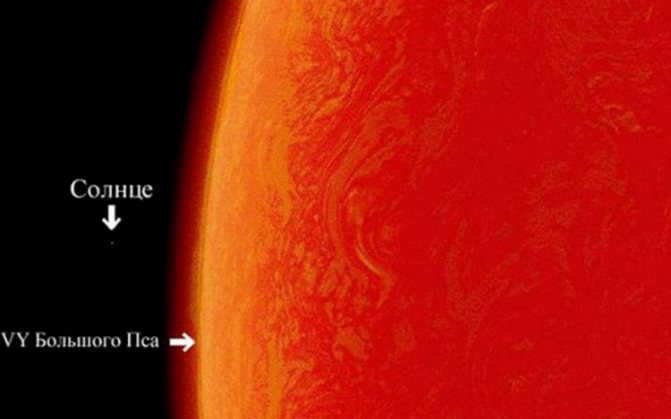
The comparison of the Sun to VY
VY, a star located above the tail of the Dog, is an irregular variable that exhibits a range of brilliance from 6.5 to 9.4m.
VY stands as one of the most colossal stars ever documented. As depicted in the image above, our Sun appears minuscule in comparison to VY. VY possesses a diameter nearly 1,500 times that of the Sun. It is postulated that this star continues to expand. Additionally, it lies approximately 4,000 light years away from our planet.
When observed through binoculars, the star’s distinct orange hue is visible, although due to its low luminosity, further details remain obscured.
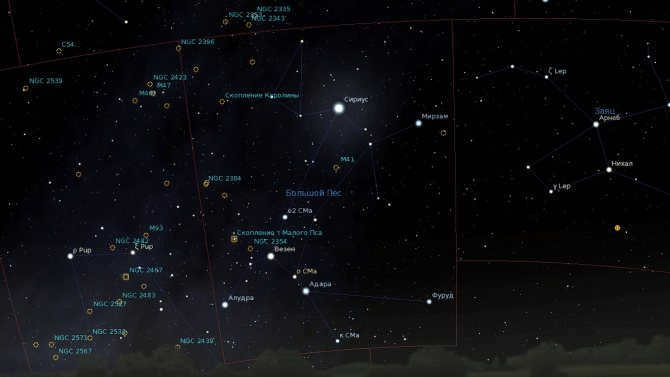
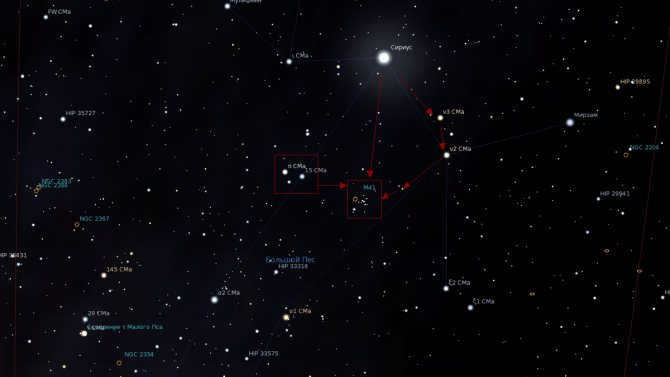
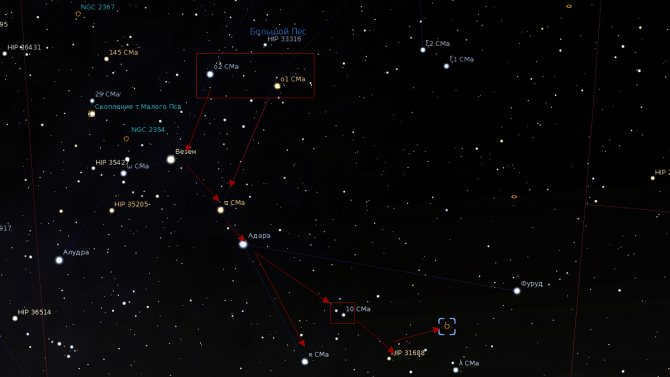
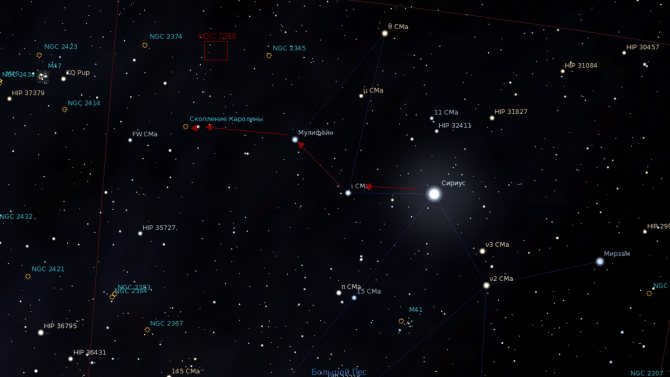
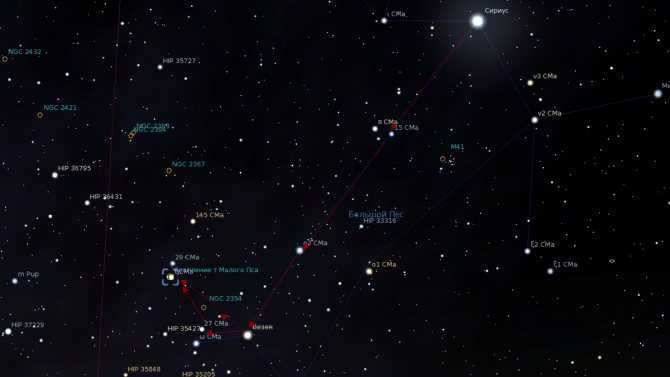
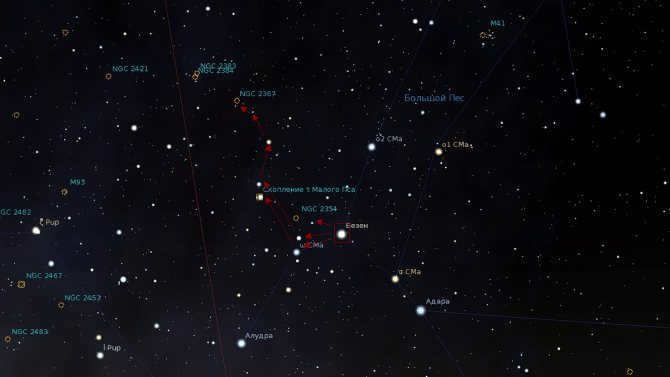
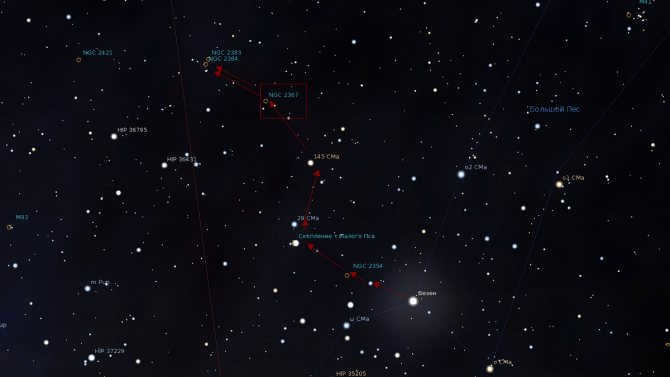
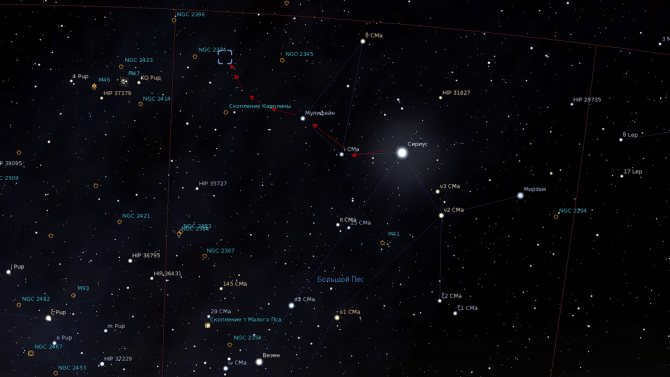
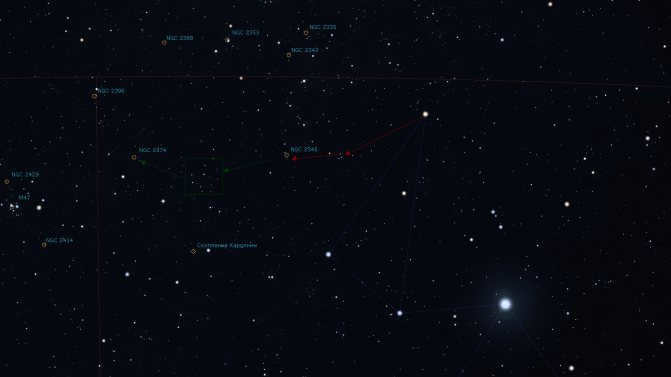
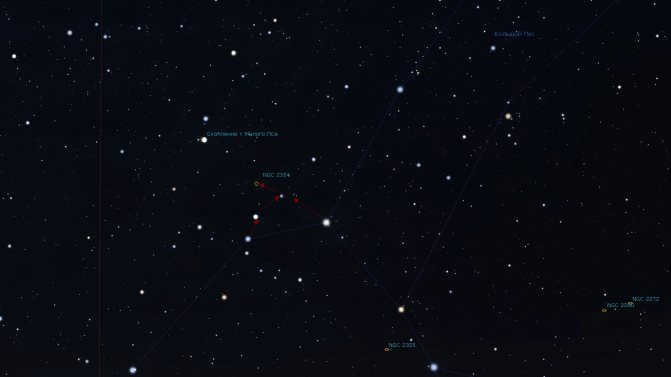
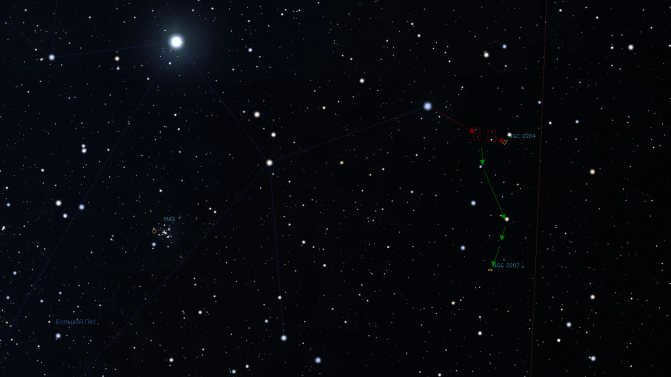
The unstable star, known as Big Dog’s VY, has released a significant amount of its mass into the nearby nebula. Experts in the field of astronomy, utilizing the powerful Hubble Space Telescope, have made the prediction that this particular star will undergo a hypernova explosion in the coming 100,000 years[21]. The potential consequences of such an event are quite significant, as it could result in the emission of gamma-ray bursts that have the potential to cause damage to the surrounding universe. This destructive force could potentially eradicate any form of cellular life within a few light years of the explosion. Fortunately, the distance between Earth and this hypergiant is significant enough that it does not pose a direct threat to our planet.
Notes
- ↑ 12
Lada, C. J.; Reid, M. (March 1976). “The identification of a molecular cloud linked to VY CMa”. Bulletin of the American Astronomical Society (American Astronomical Society) 8: 322. - ↑ 12
“Hipparchos catalog: search form”. CASU Astronomical Data Center. Cambridge Astronomical Survey Unit. 2006. - “GCVS Query=VY CMa”. General Catalogue of Variable Stars @ Sternberg Astronomical Institute, Moscow, Russia.
- ↑ 123456
SIMBAD (English). — VY Canis Majoris in the SIMBAD database. Retrieved November 14, 2009. - ↑ 12
Lipscy, S. J.; Jura, M.; Reid, M. J. (June 10, 2005). “Radio photosphere and mass-loss envelope of VY Canis Majoris”. The Astrophysical Journal (The American Astronomical Society) 626 (1): 439–445. arXiv:astro-ph/0502586. Bibcode 2005ApJ…626..439L. doi:10.1086/429900 - Monnier, J. D.; Geballe, T. R.; Danchi, W. C. (August 1, 1998). “Temporal variations of midinfrared spectra in late-type stars”. The Astrophysical Journal (American Astronomical Society) 502 (2): 833–846. arXiv:astro-ph/9803027. Bibcode 1998ApJ…502..833M. doi:10.1086/305945.
- ↑ 123
Wittkowski, M.; Langer, N.; Weigelt, G. (October 27, 1998). «Diffraction-limited speckle-masking interferometry of the red supergiant VY CMa». Astronomy and Astrophysics (European Southern Observatory) 340: 39–42. - Monnier, J. D.; Danchi, W. C.; Hale, D. S.; Lipman, E. A.; Tuthill, P. G.; Townes, C. H. (November 10, 2000). «Mid-infrared interferometry on spectral lines. II. Continuum (dust) emission around IRC +10216 and VY Canis Majoris». The Astrophysical Journal (The American Astronomical Society) 543 (2): 861–867. arXiv:astro-ph/0007393. Bibcode 2000ApJ…543..861M. doi:10.1086/317126
- ↑ 12345
Humphreys, Roberta (October 13, 2006). “VY Canis Majoris: the scientific explanation for its brightness”. arXiV. arXiv:astro-ph/0610433. - ↑ 1234
Lada, Charles J.; Reid, Mark J. (January 1, 1978). “CO observations of a molecular cloud complex linked to the illuminated edge near VY Canis Majoris”. The Astrophysical Journal (American Astronomical Society) 219: 95–104. Bibcode 1978ApJ…219…95L. doi:10.1086/155758 - It takes approximately 8 minutes for light from the Sun to reach Earth.
- Gomel-Sat – Space Technology Center conducts research on hypergiant stars. They also provide services such as satellite TV, sharing, cardsharing, news, forum, and file archive.
- Roberta M. Humphreys has published a preprint on the astrophysical basis of the luminosity of VY Canis Majoris on the Preprint Archive arxiv.org.
- Philip Massey, Emily M. Levesque, and Bertrand Plez have improved the determination of the effective temperature of VY Canis Majoris. Their findings can be found on the arxiv.org preprint archive. (Checked on 05-15-07)
- Robinson, L. J. discusses three somewhat overlooked facets of VY Canis Majoris in the Information Bulletin on Variable Stars, published by Commission 27 of the I. A. U. at the Konkoly Observatory in Budapest (599).


